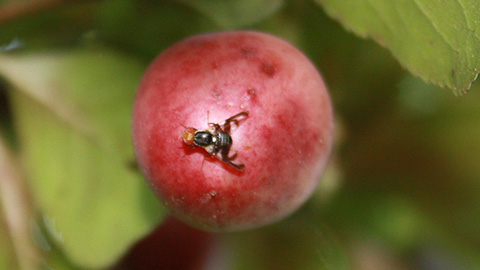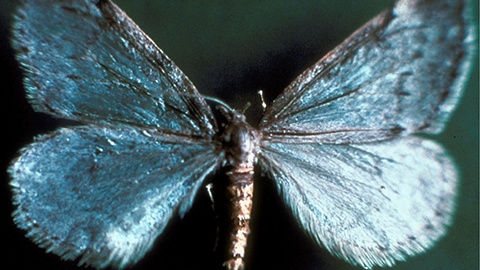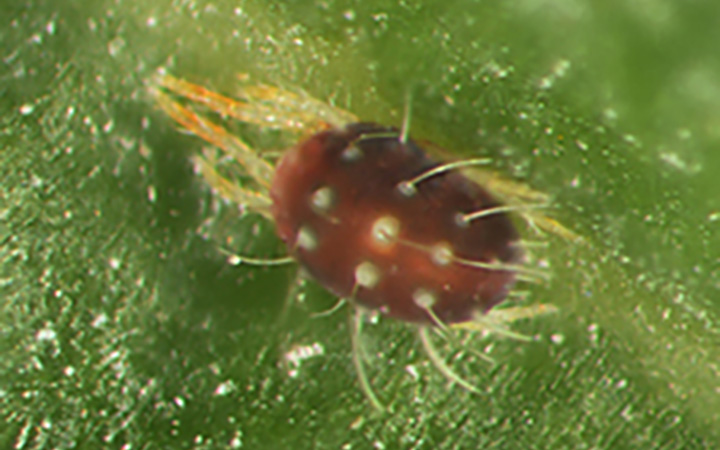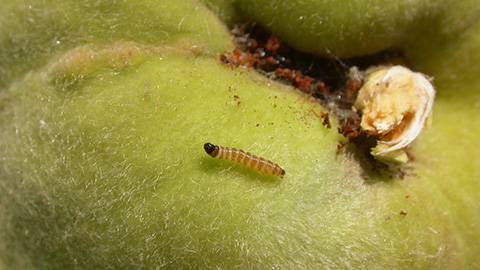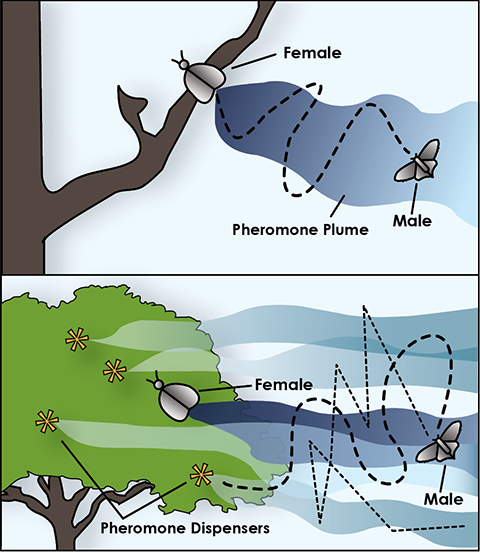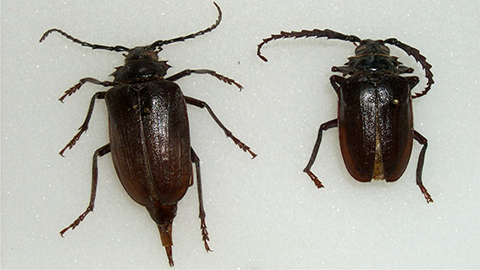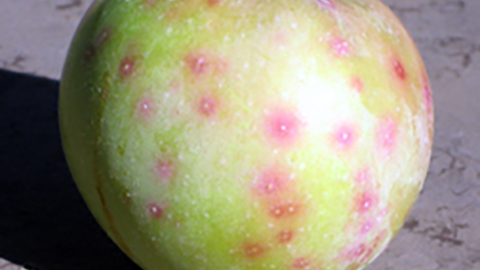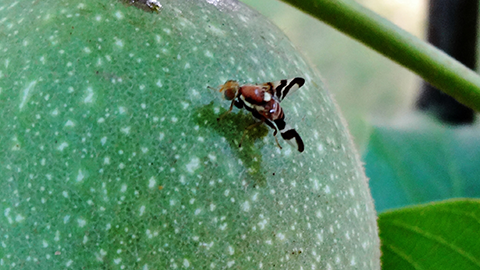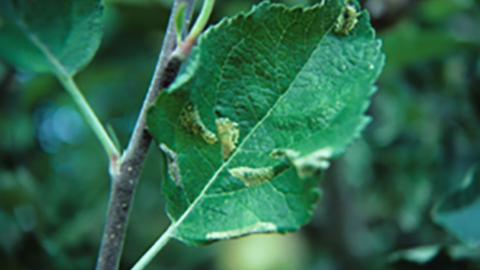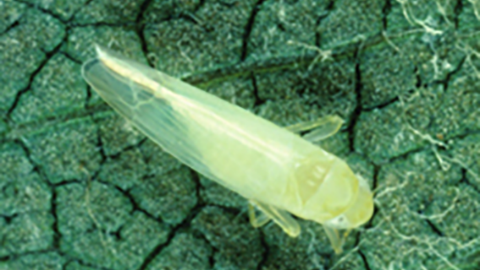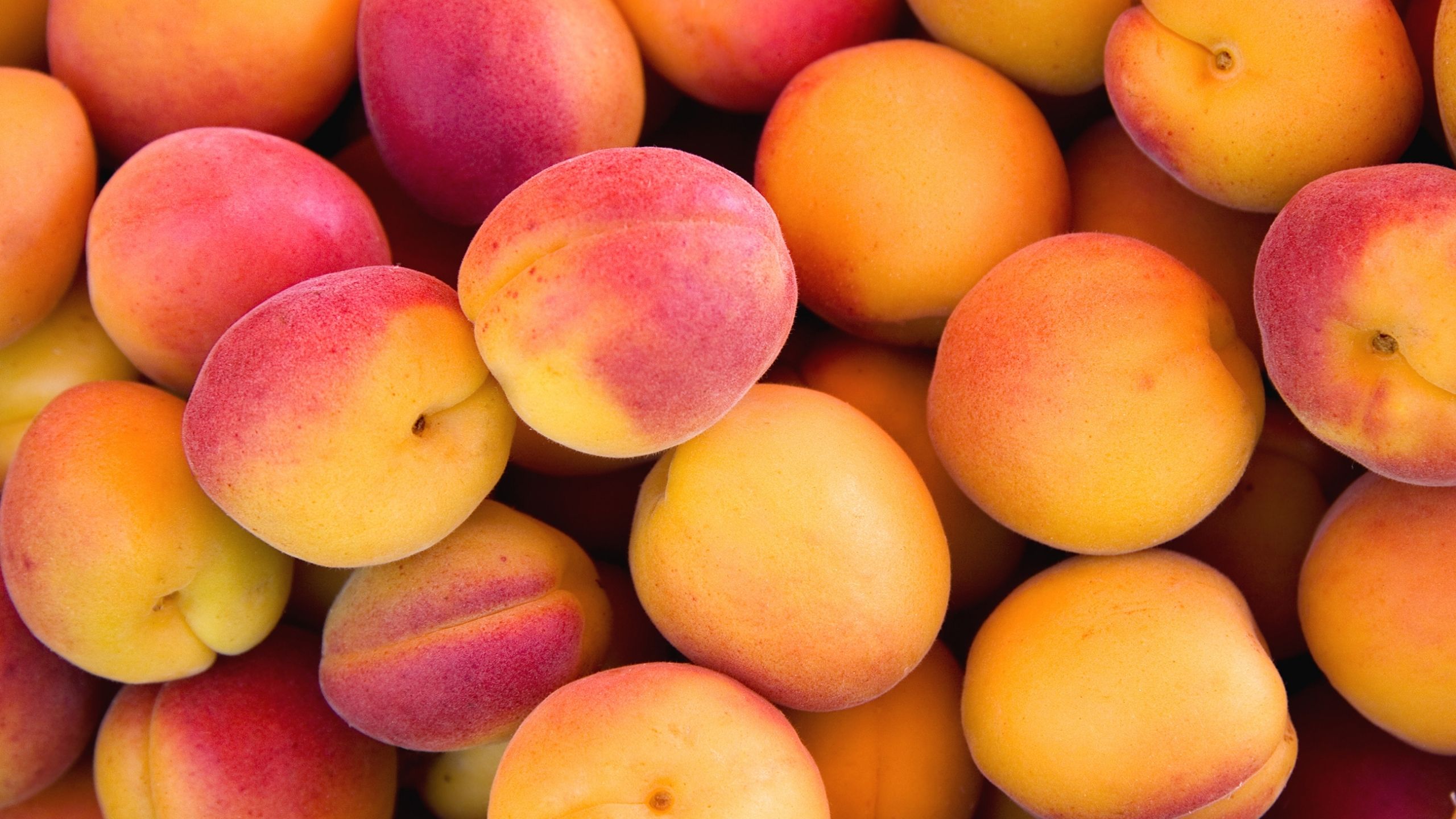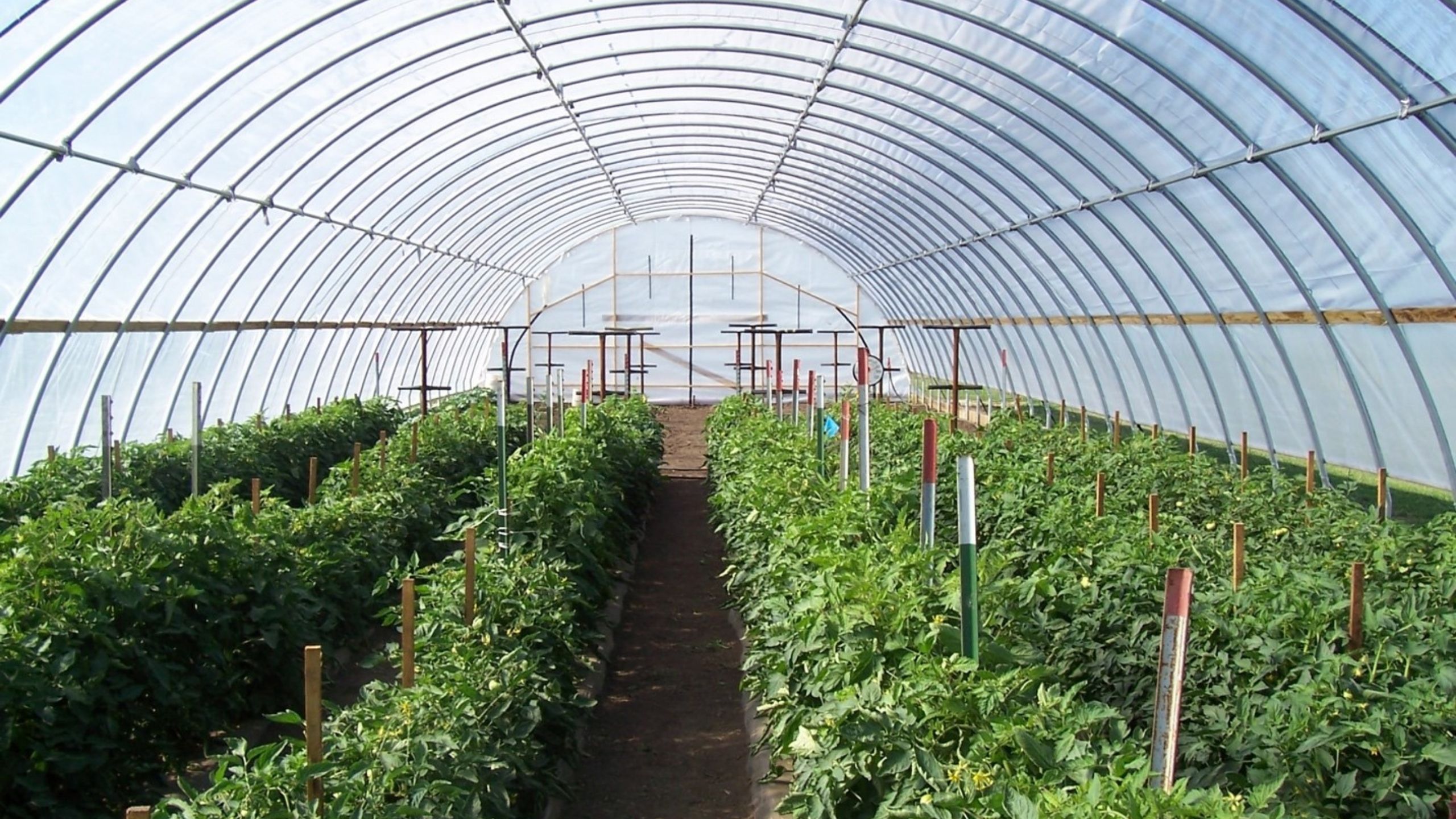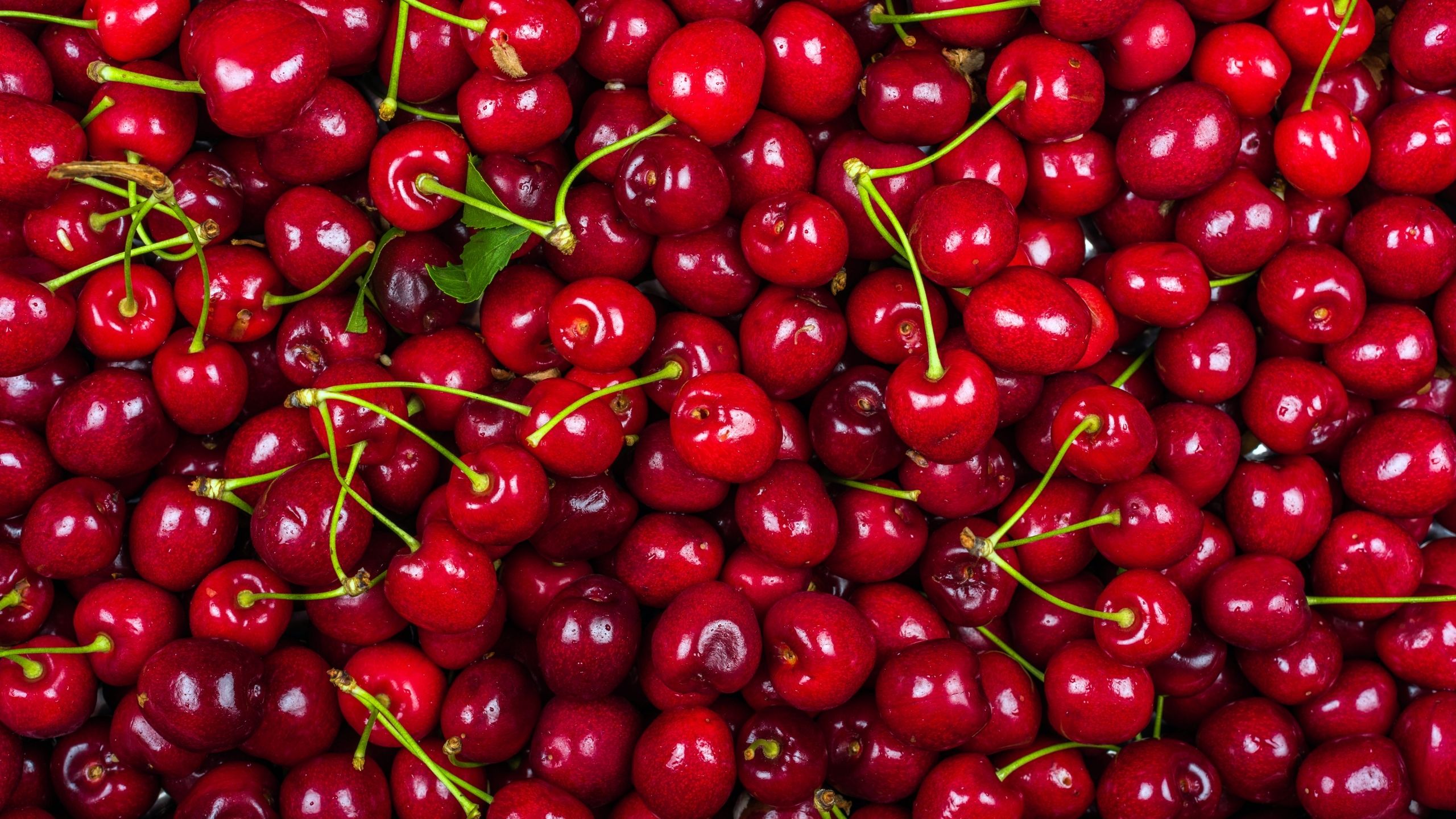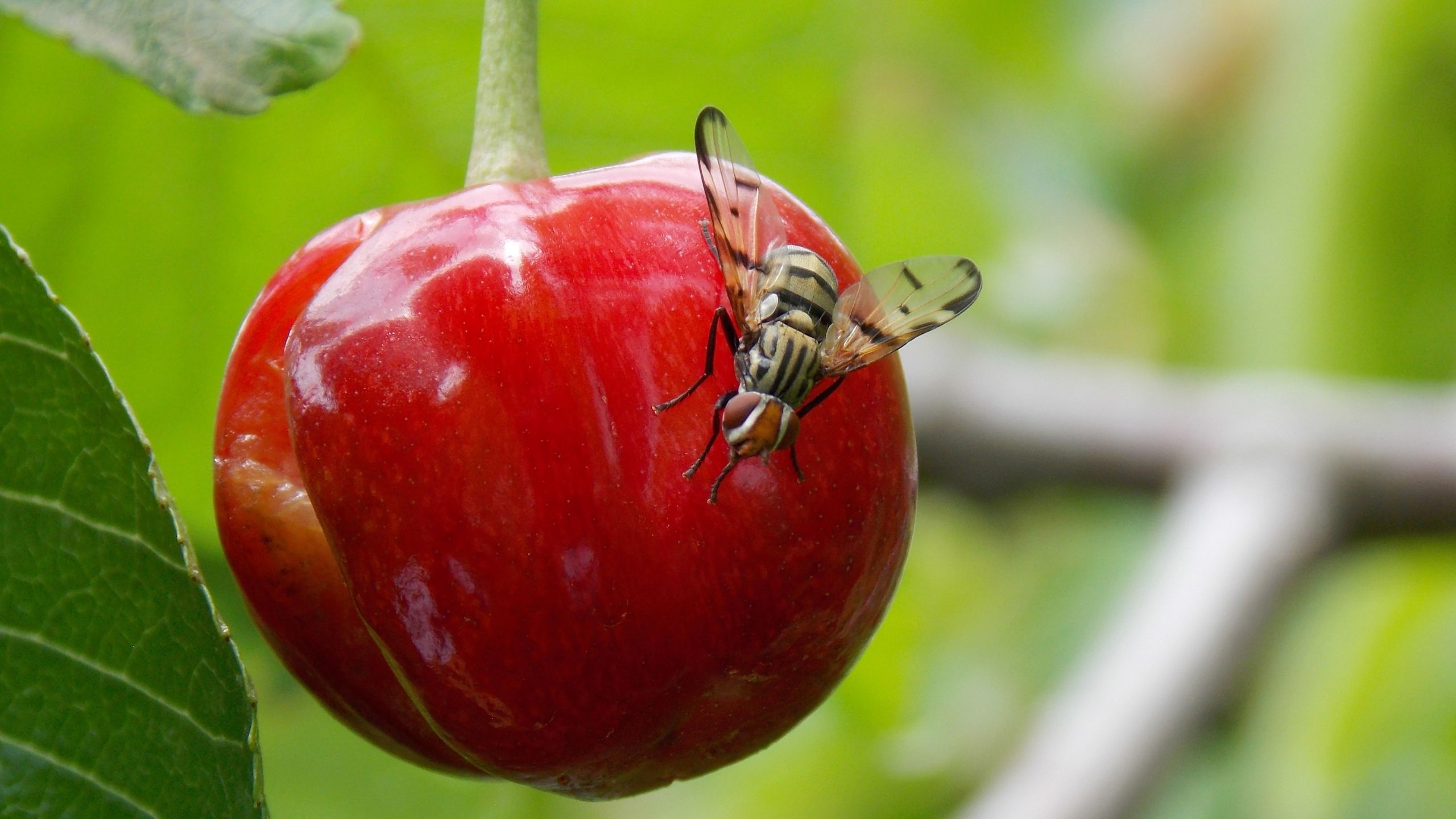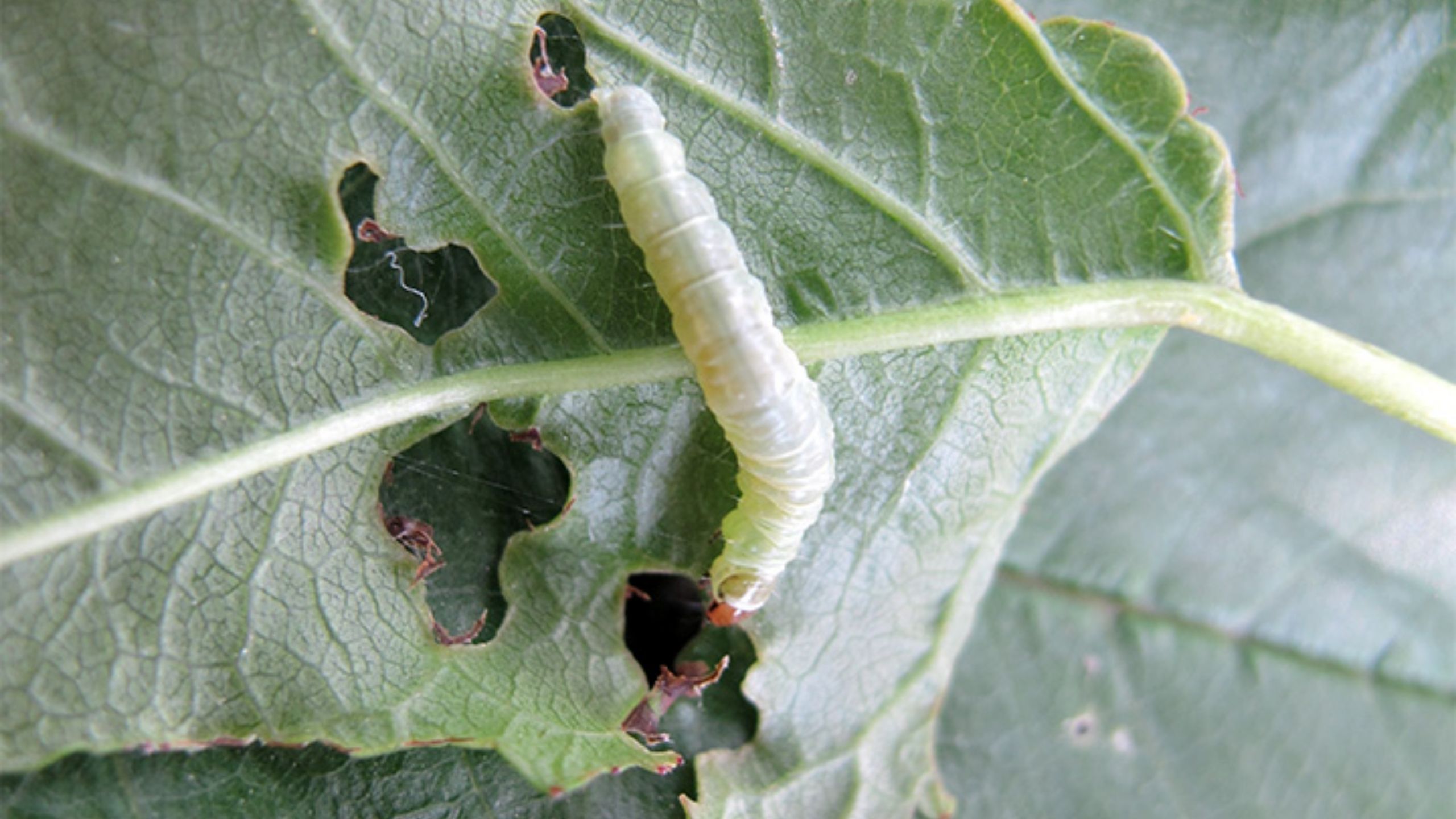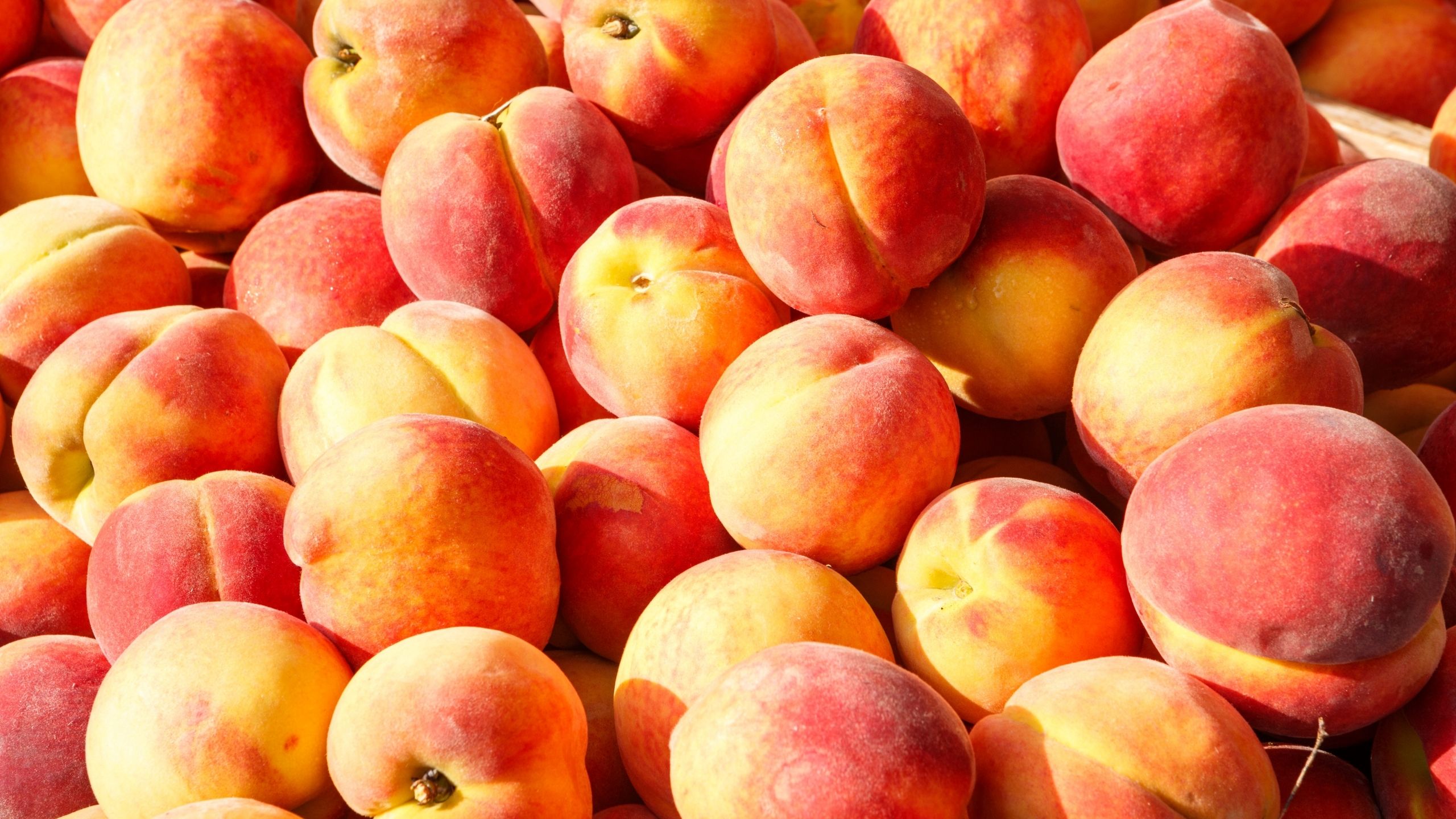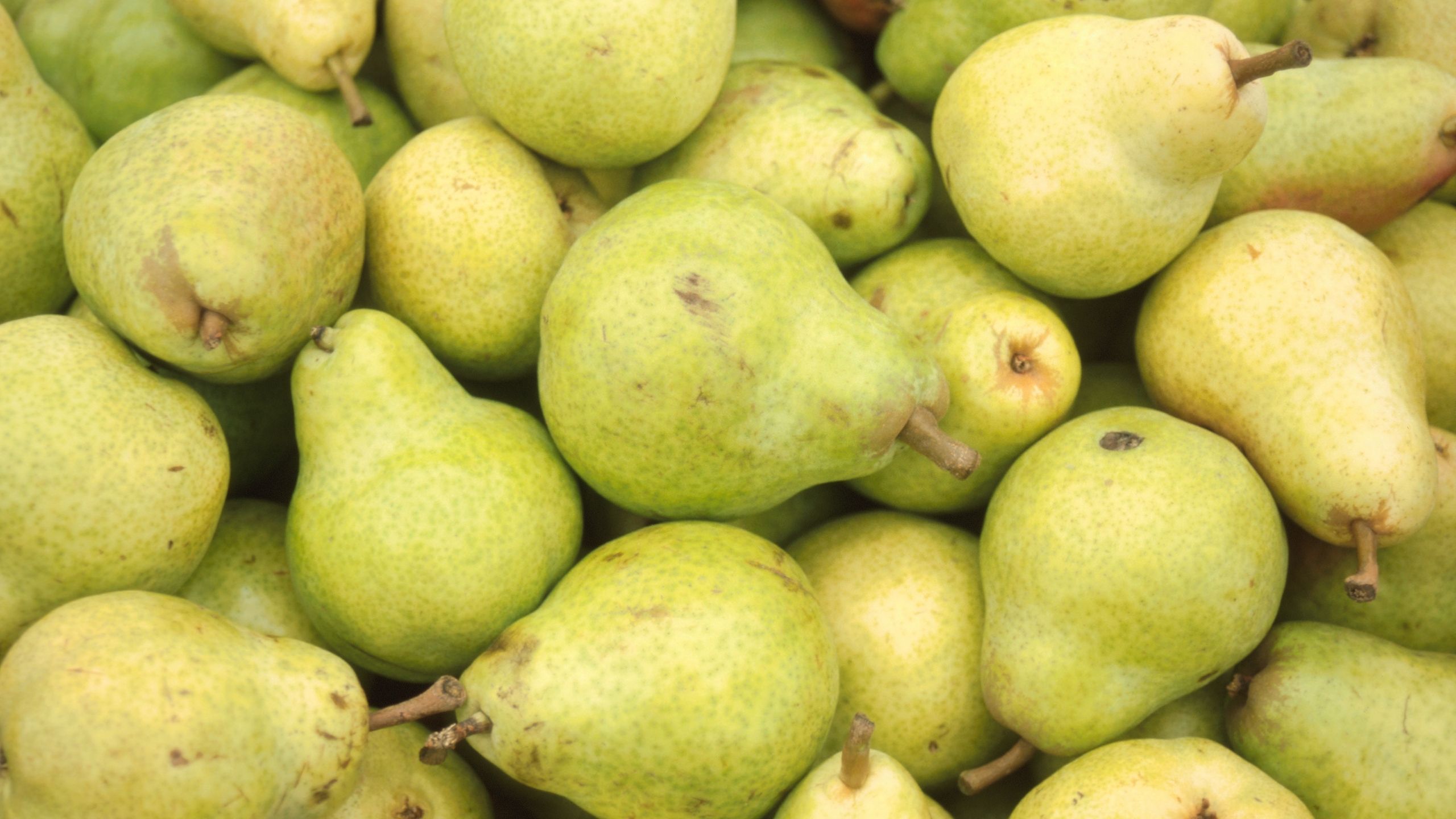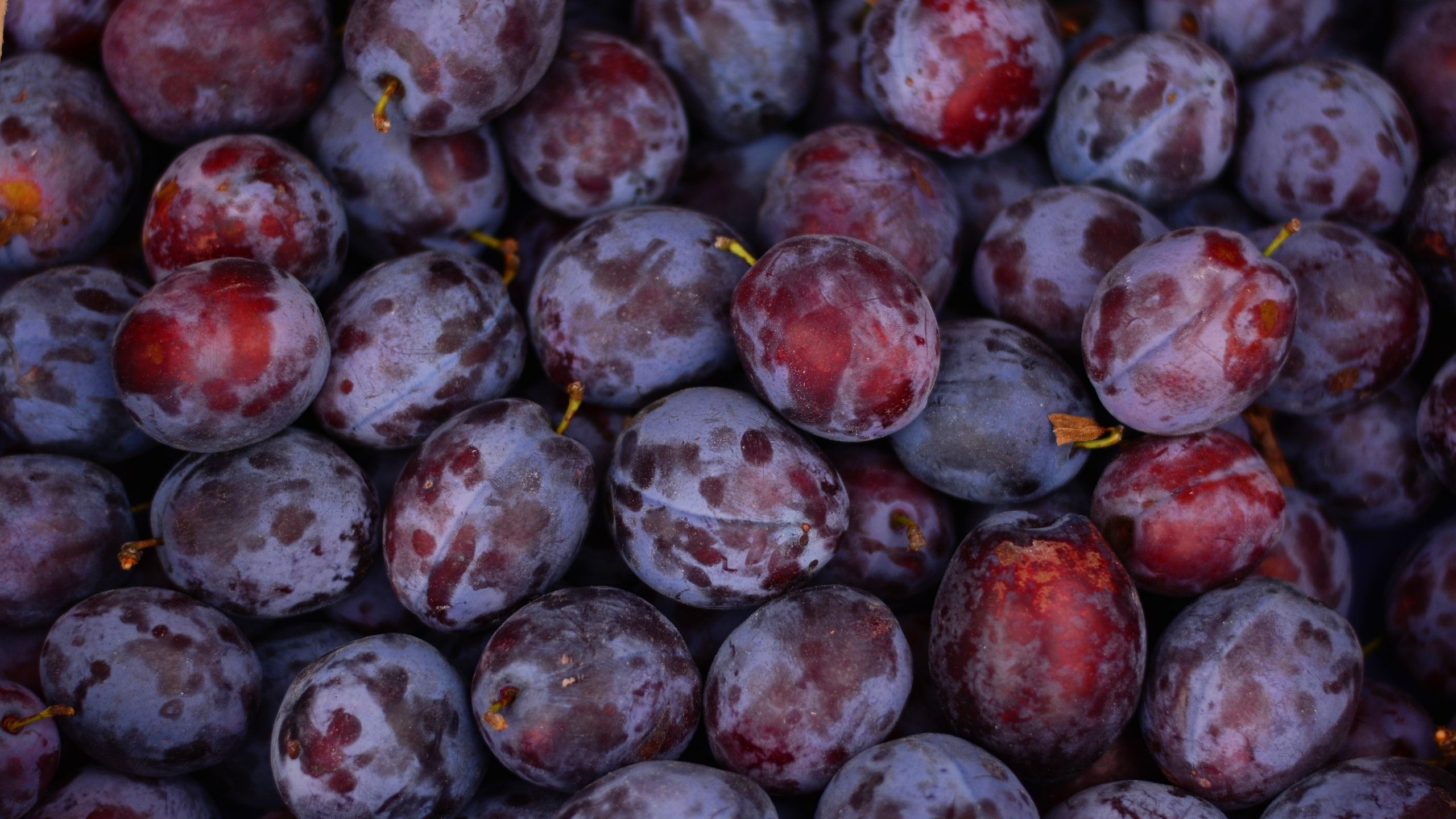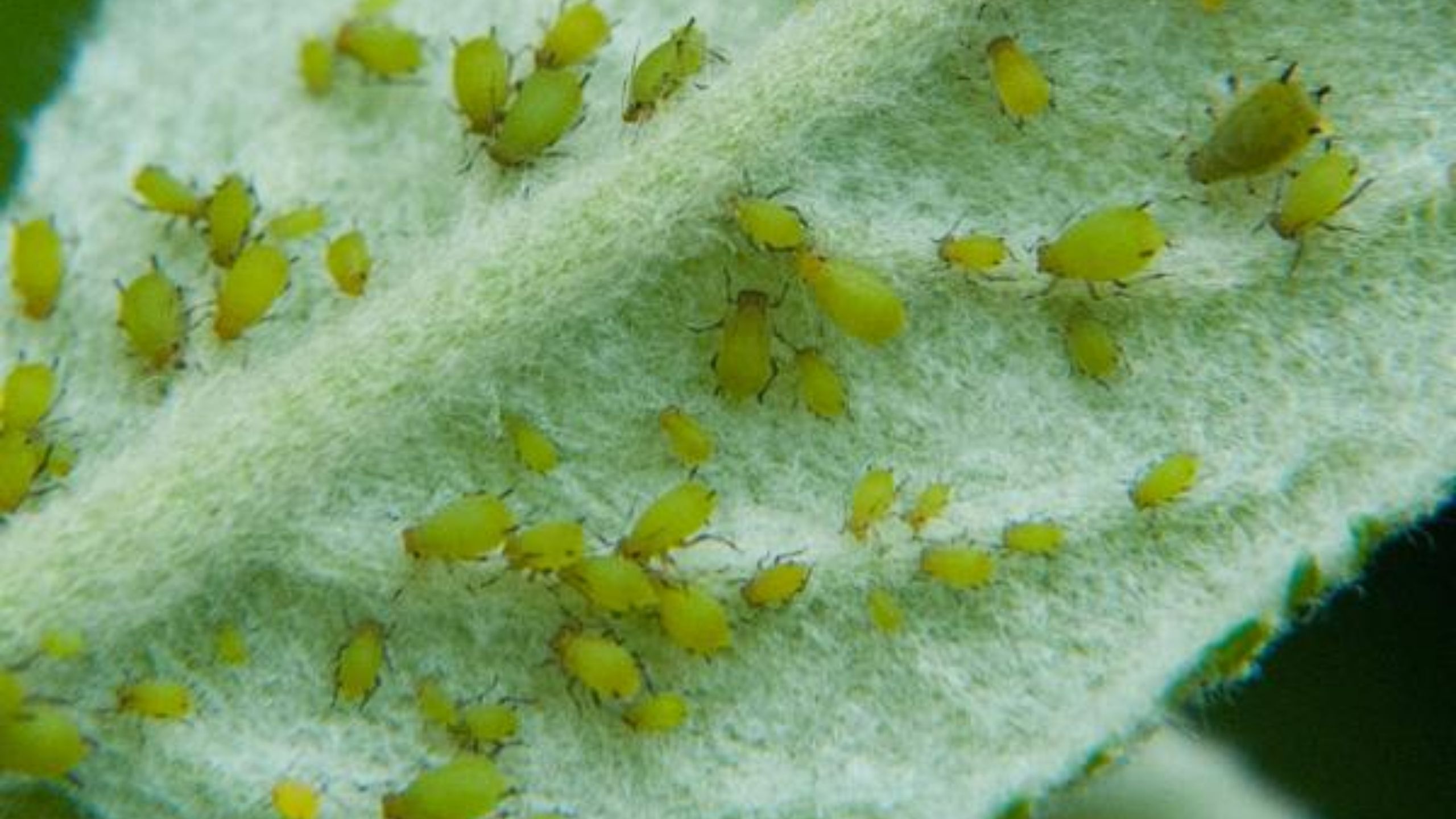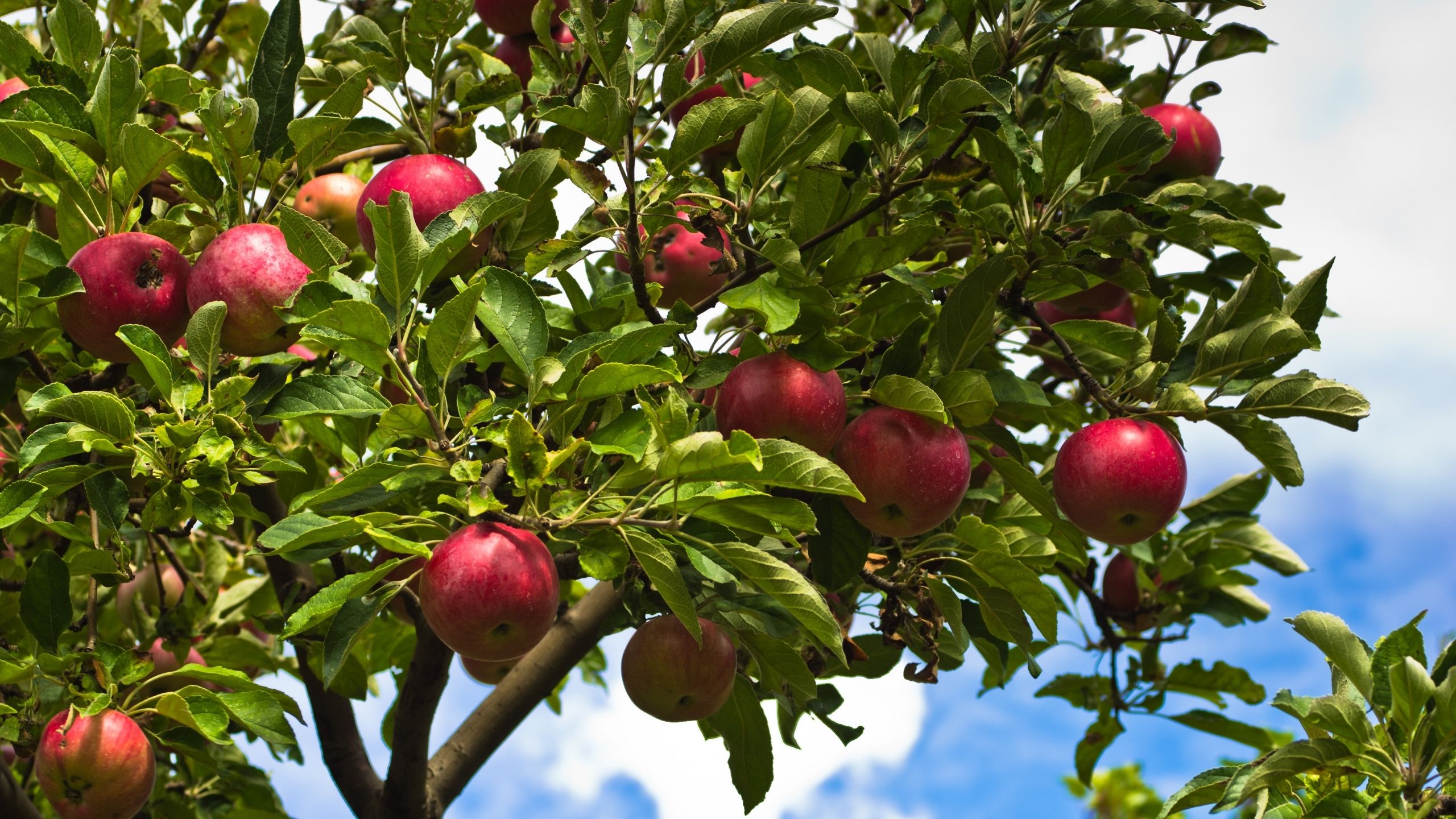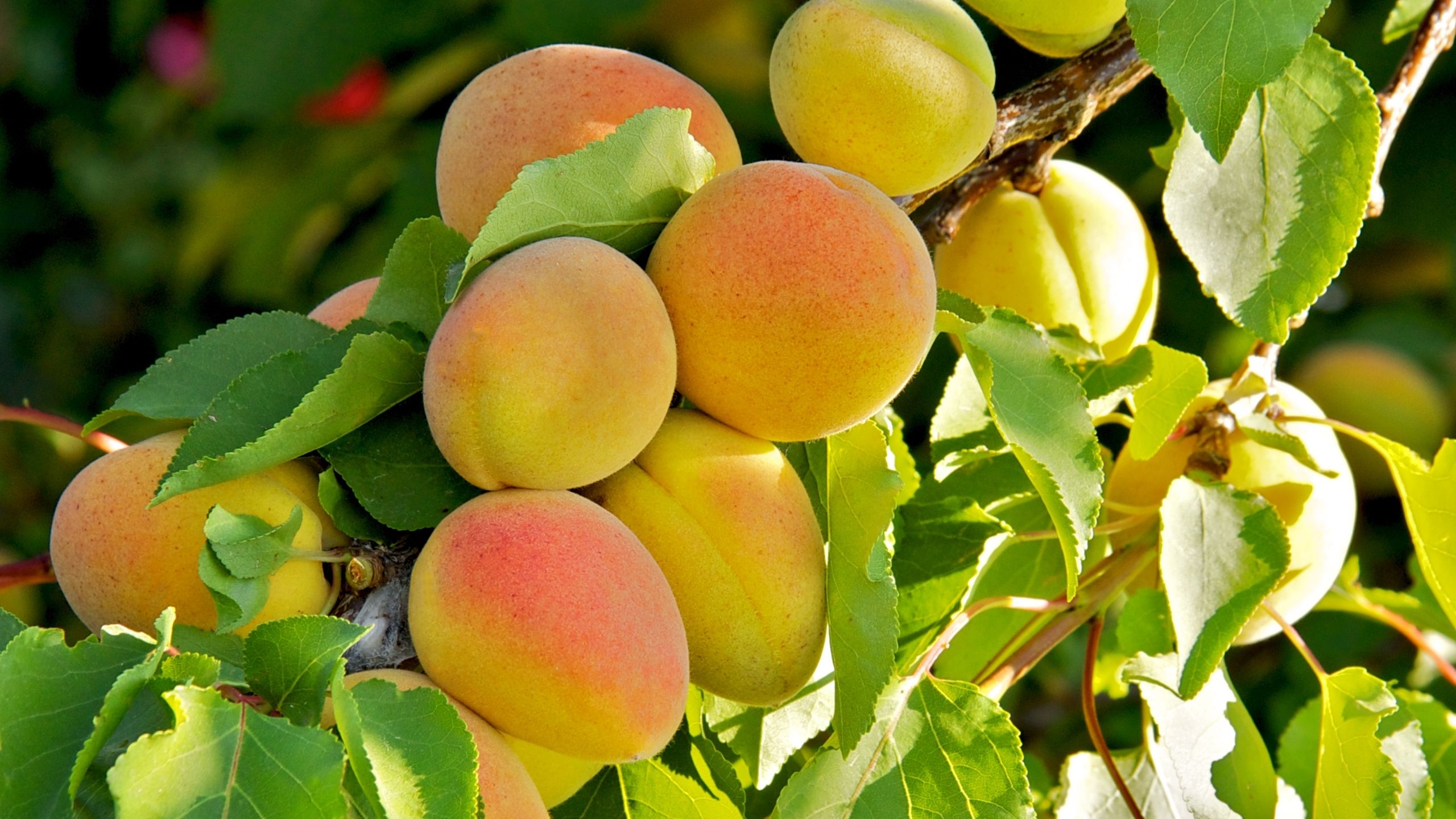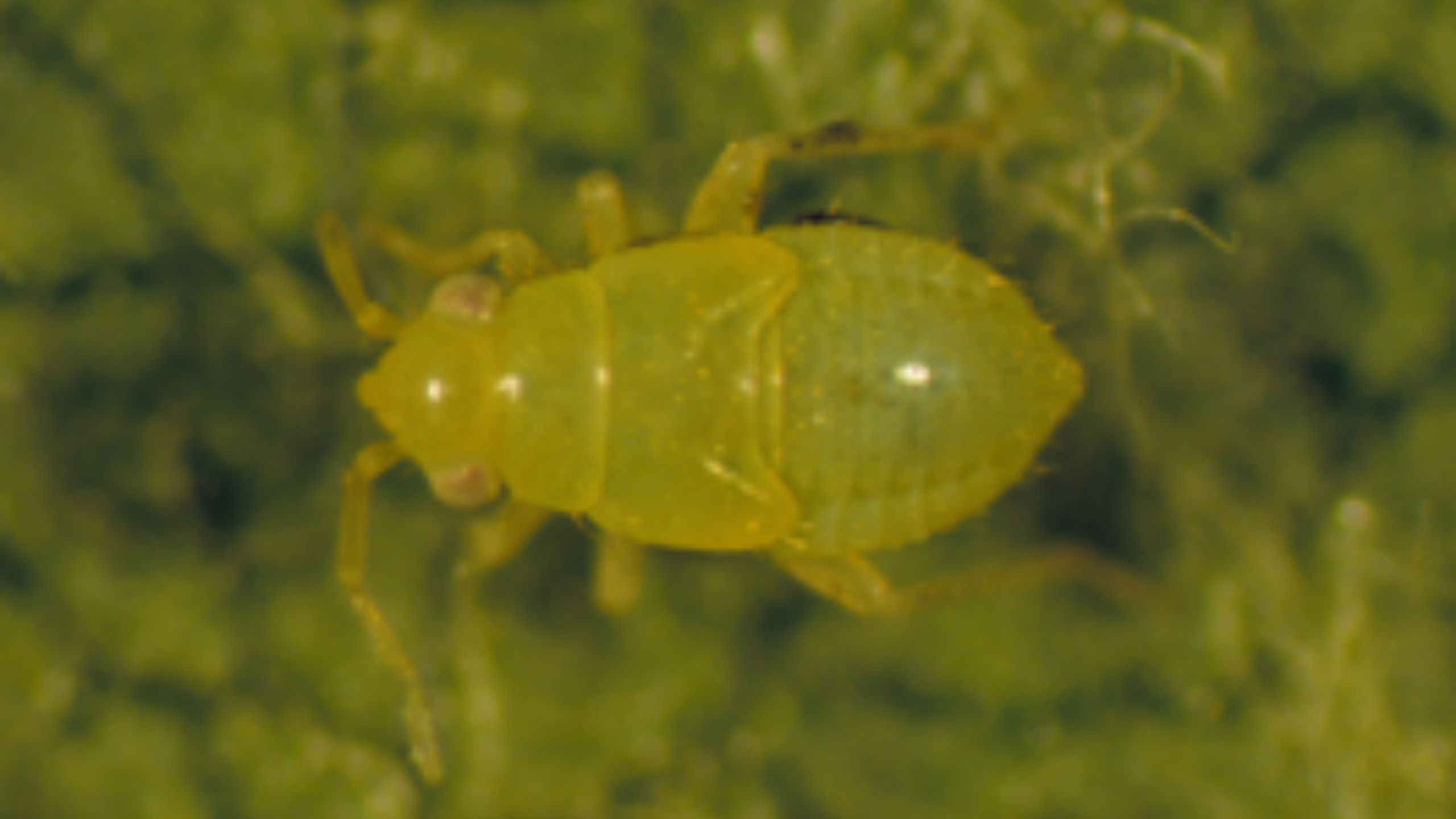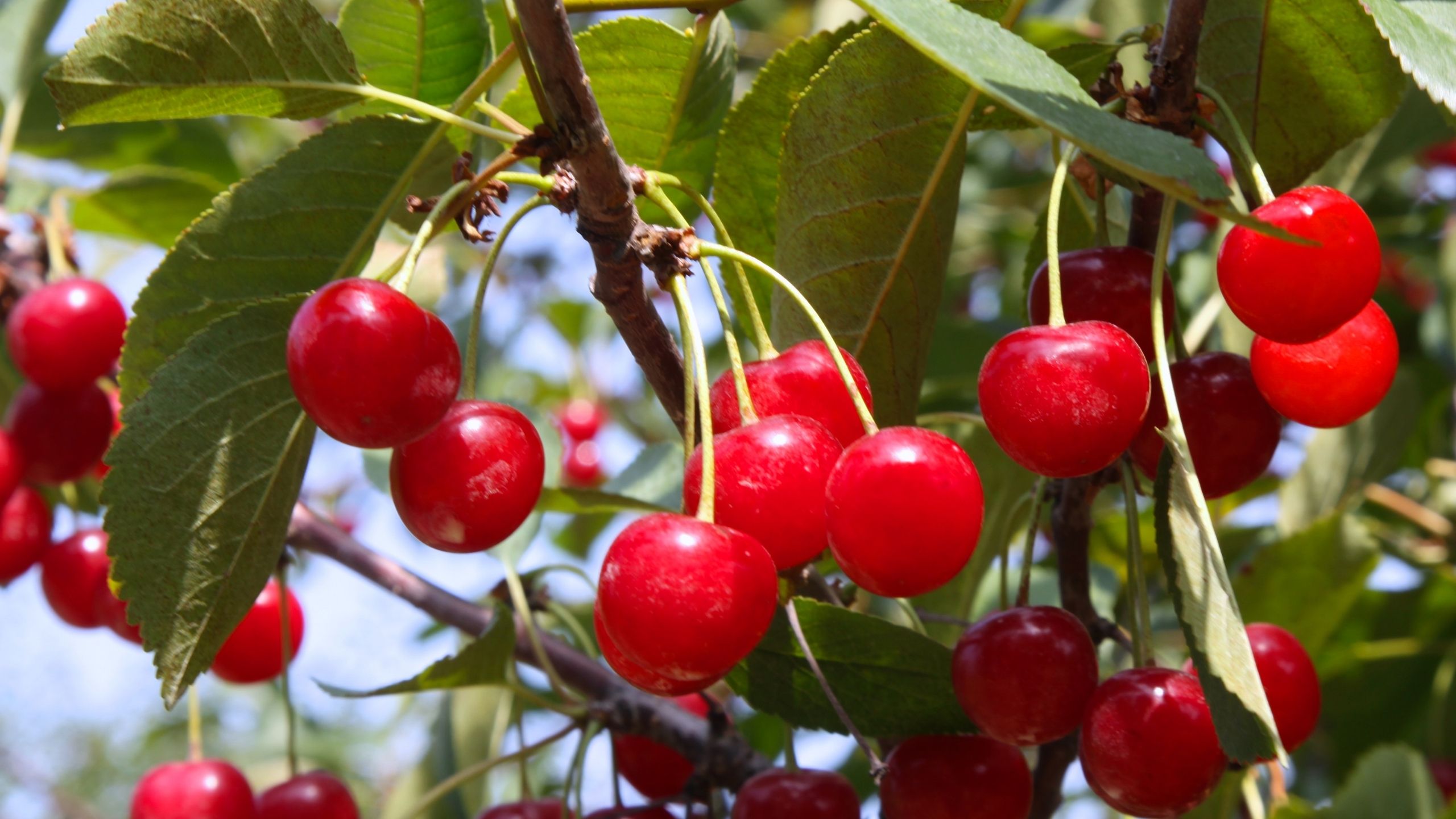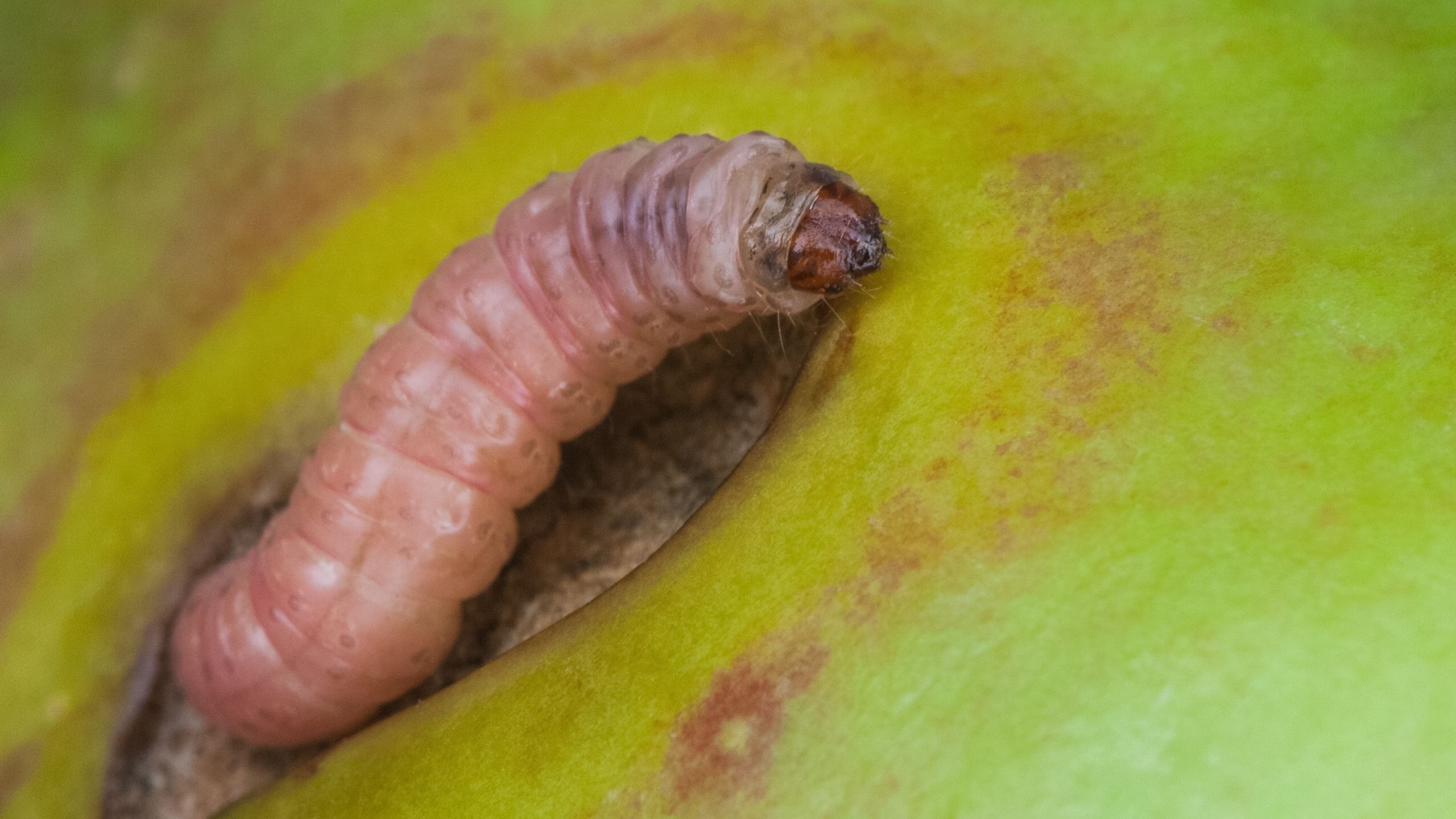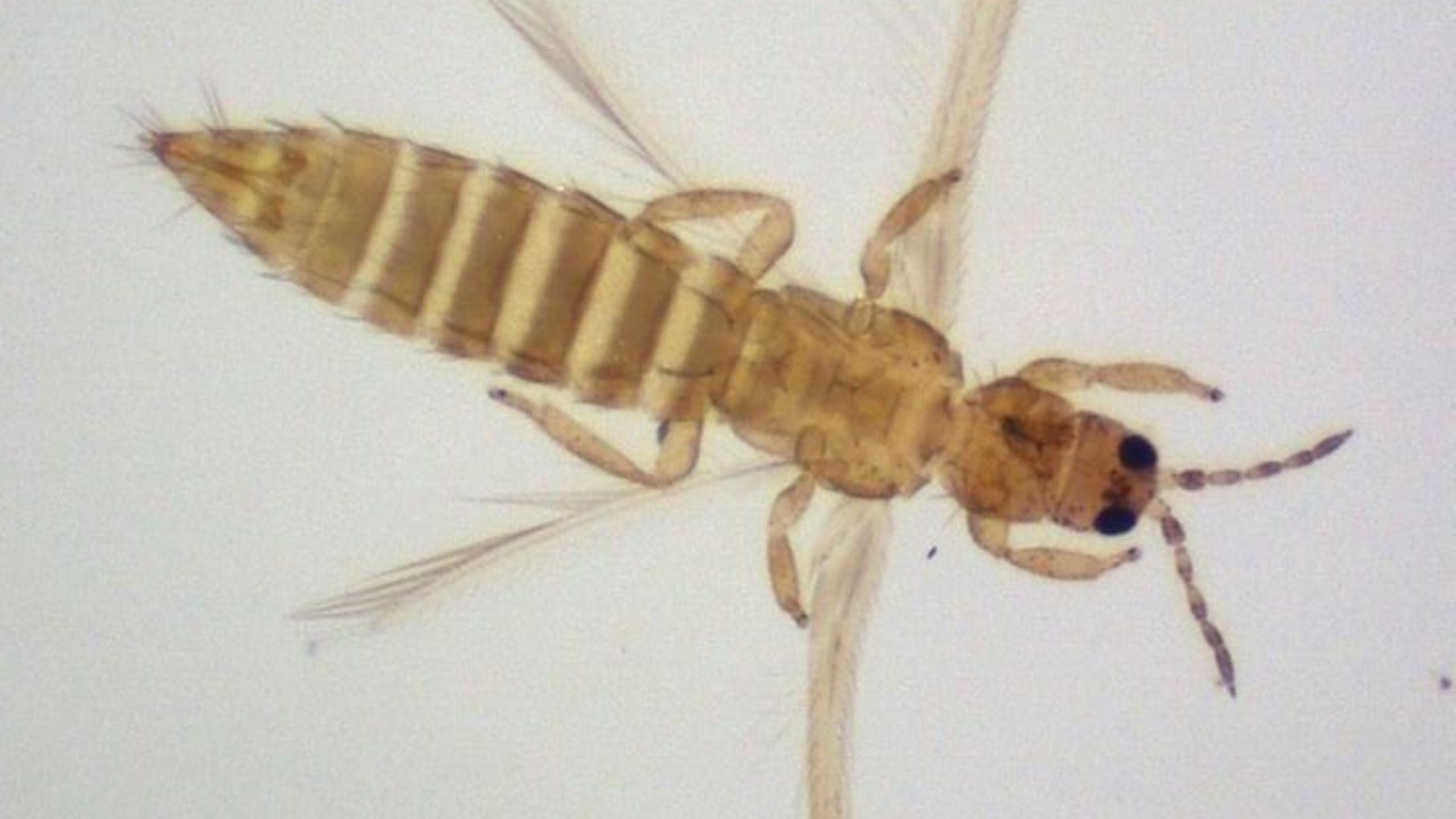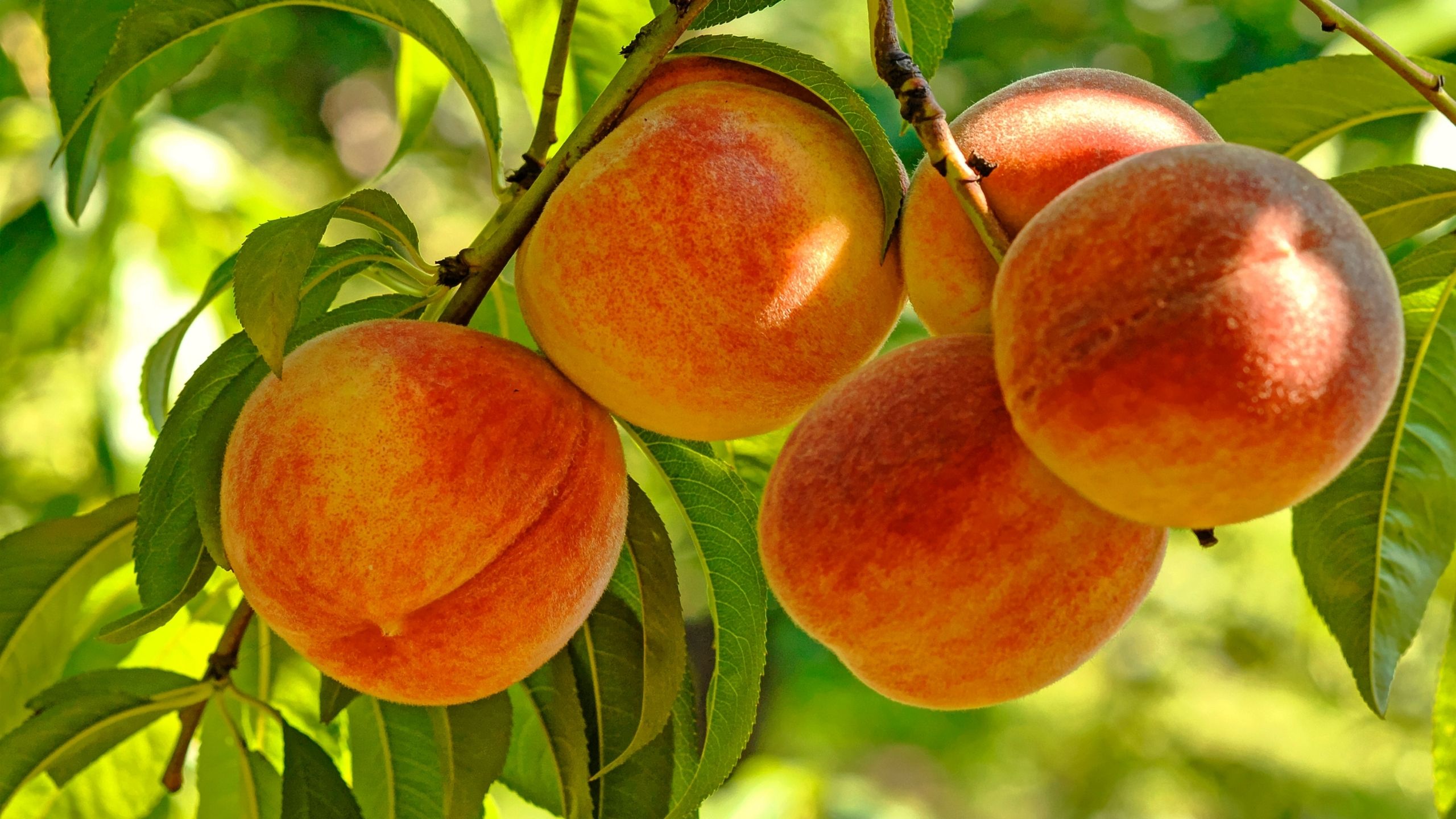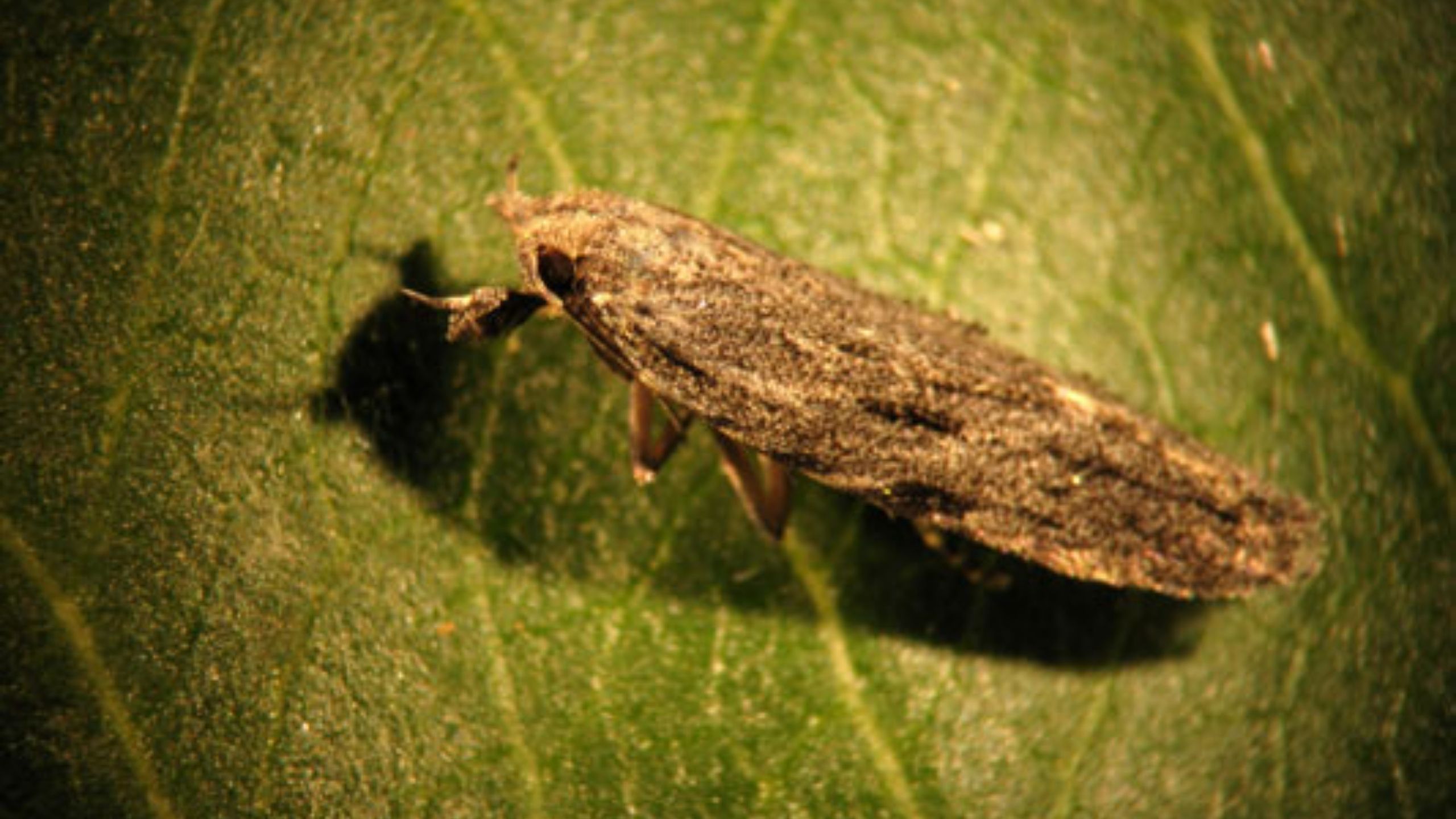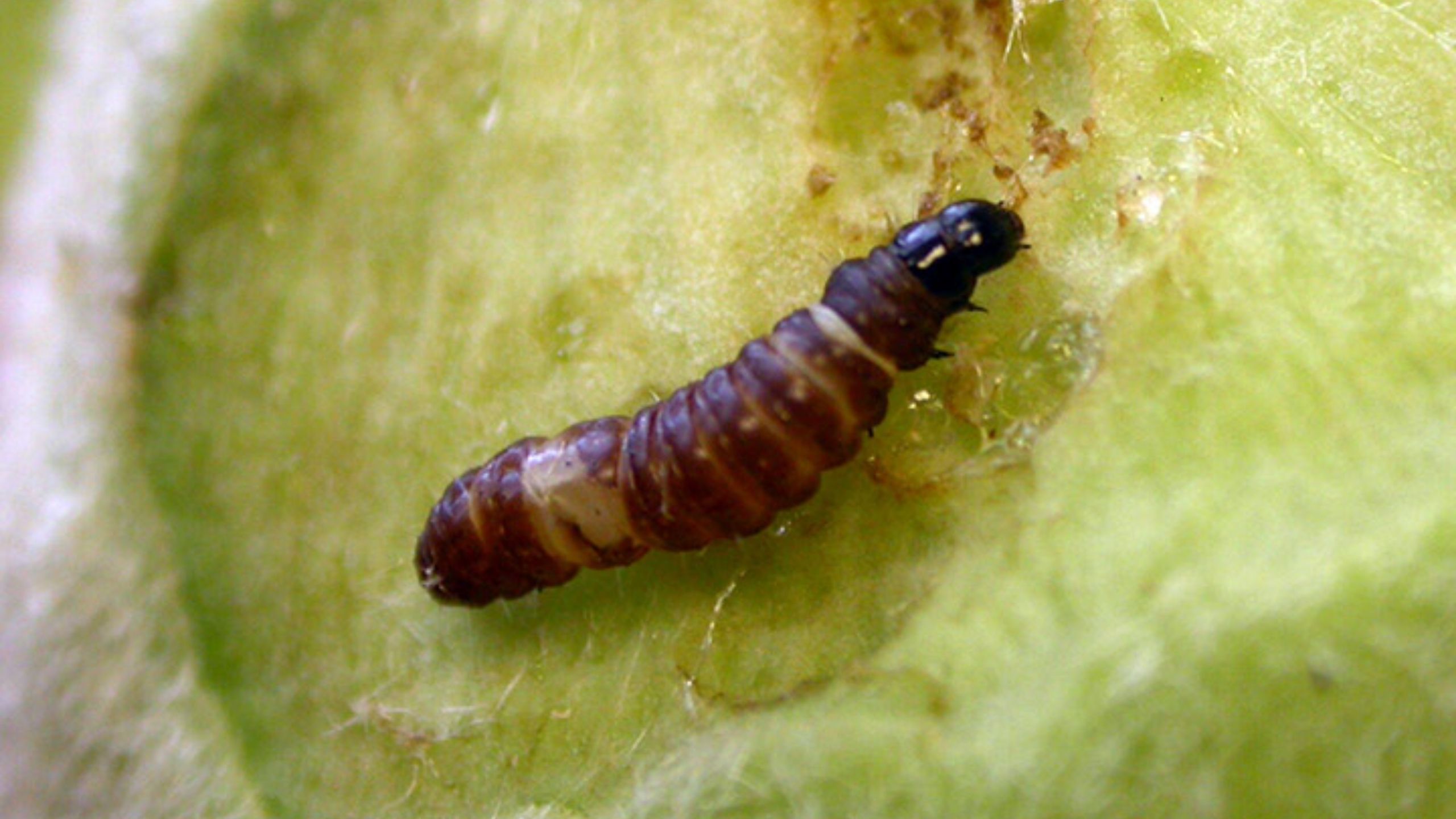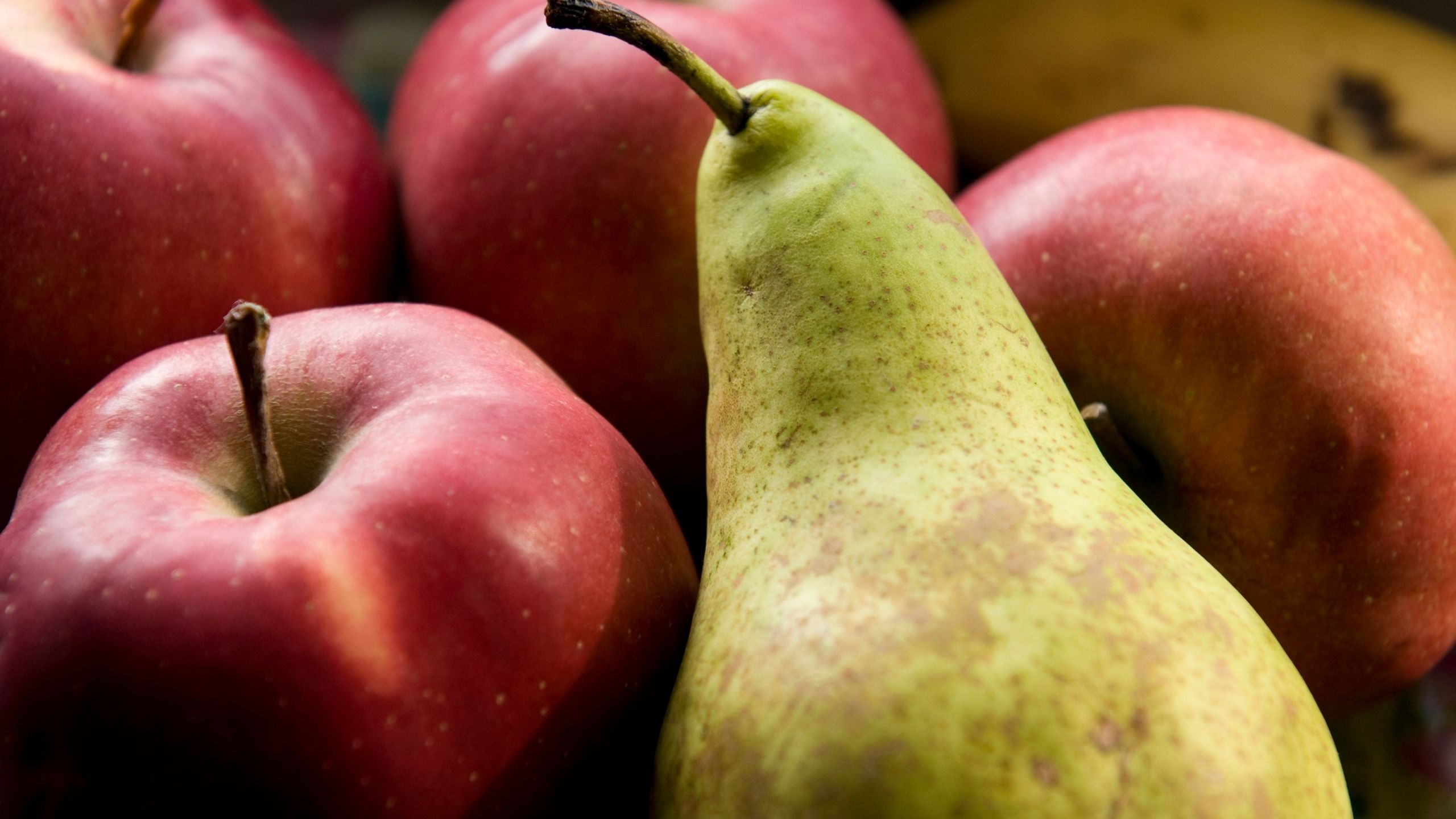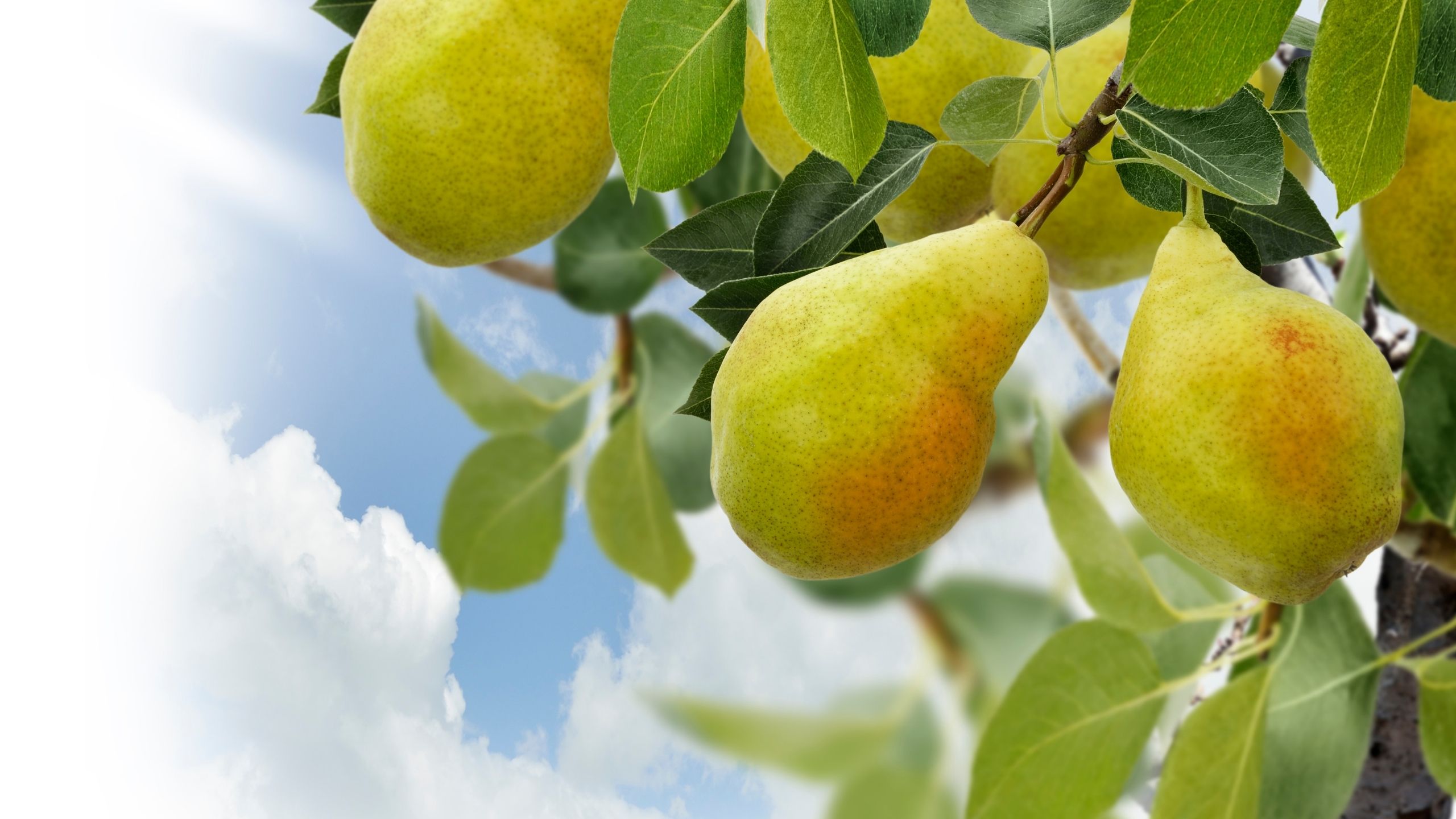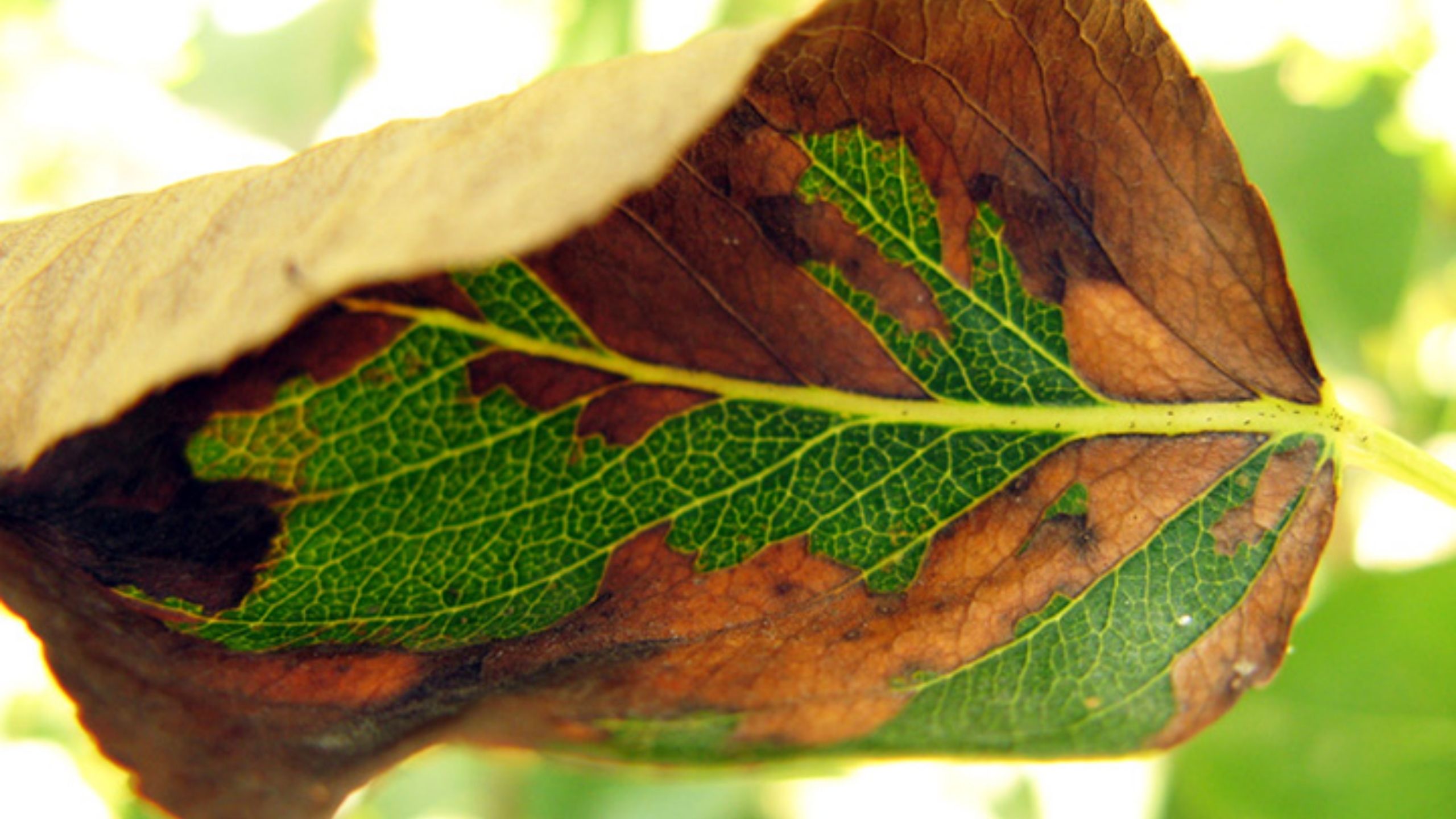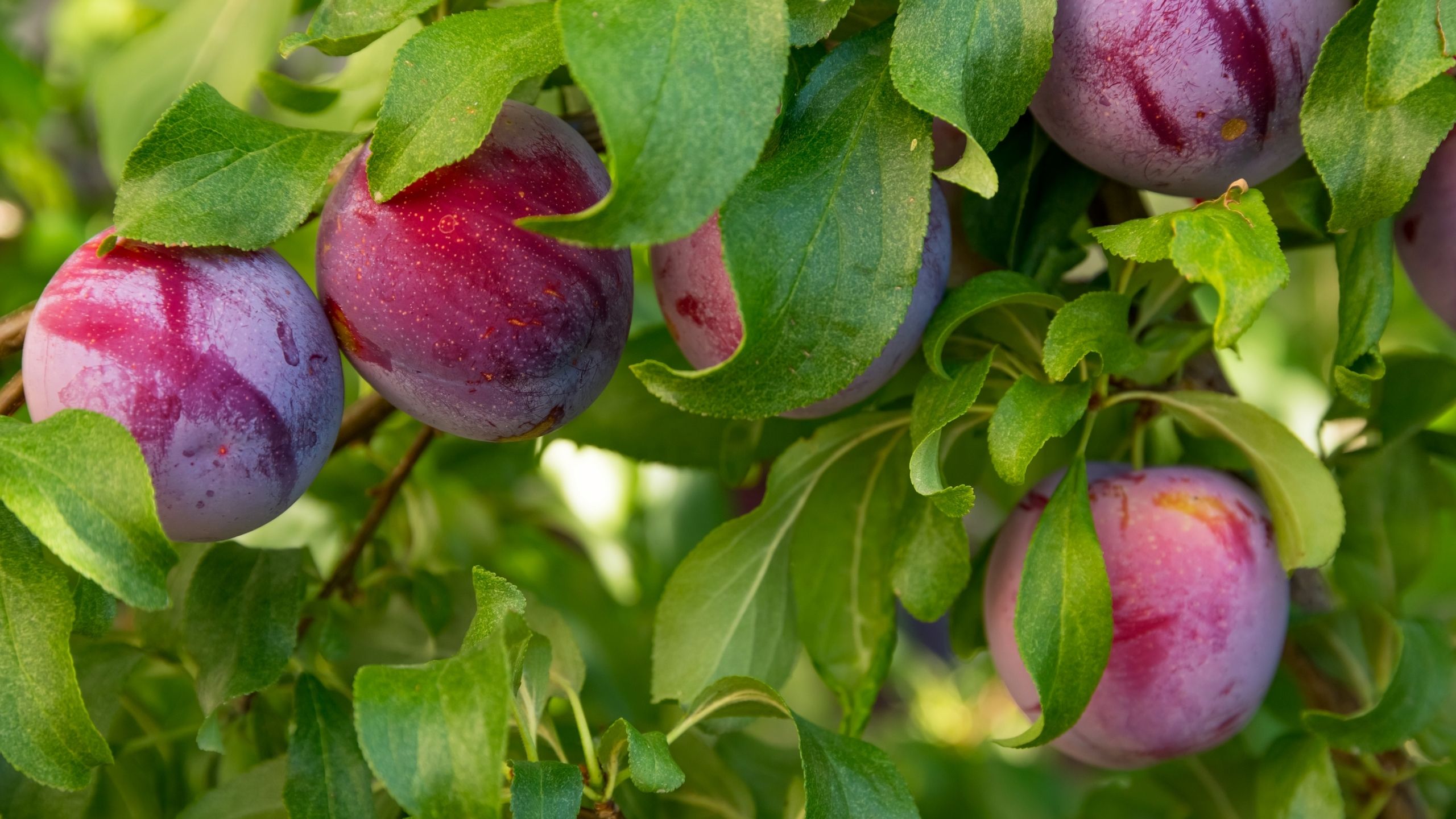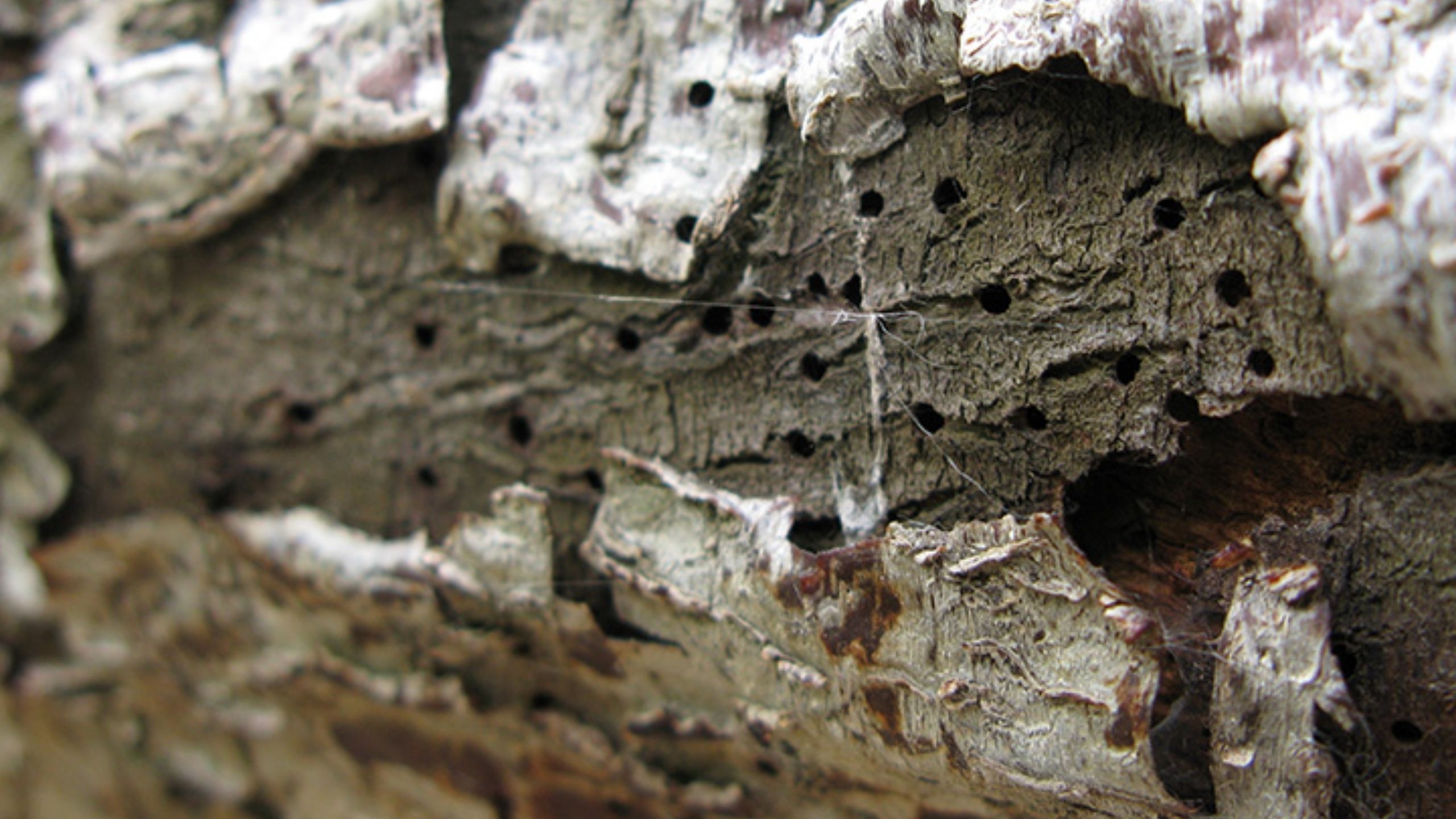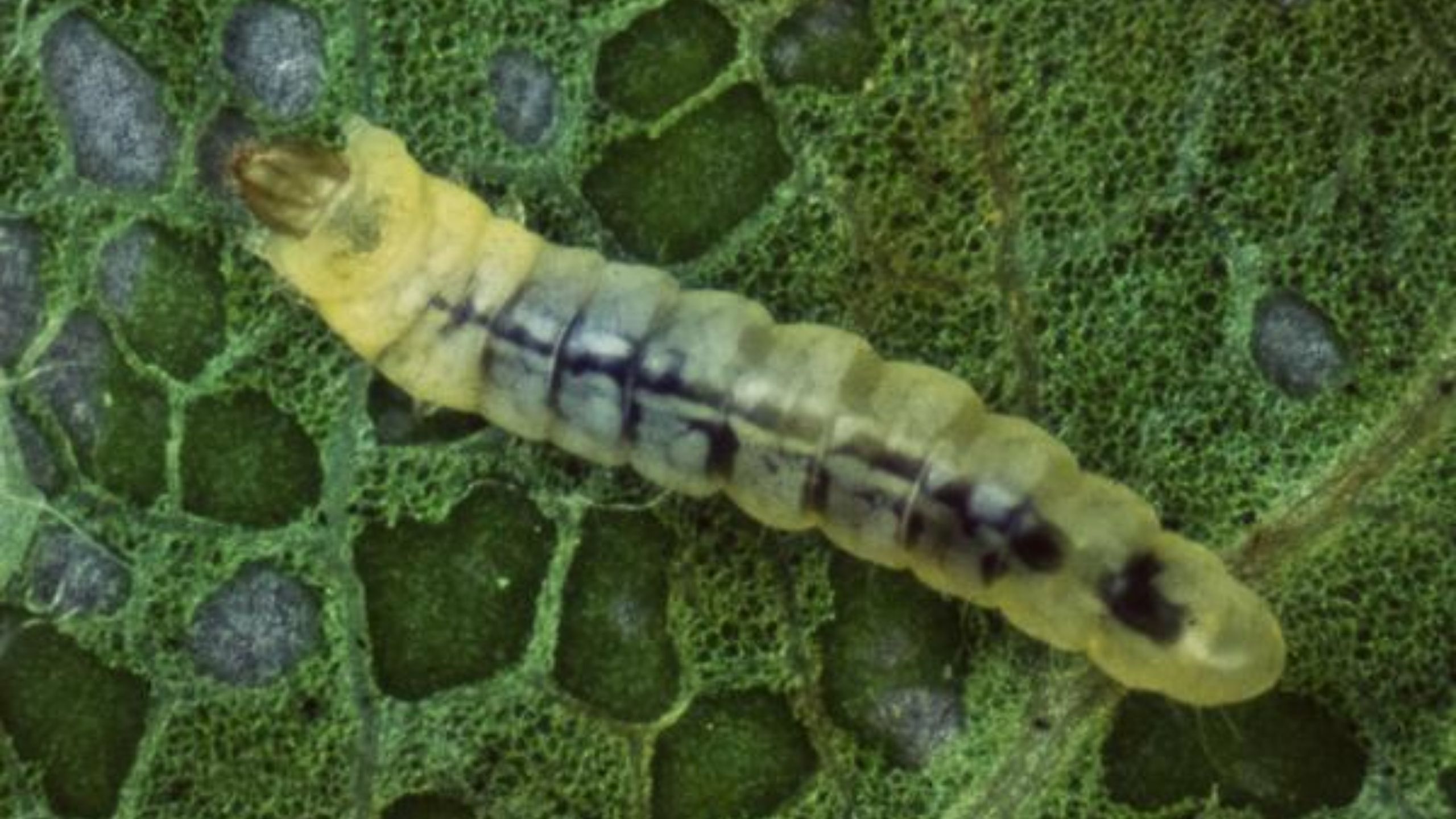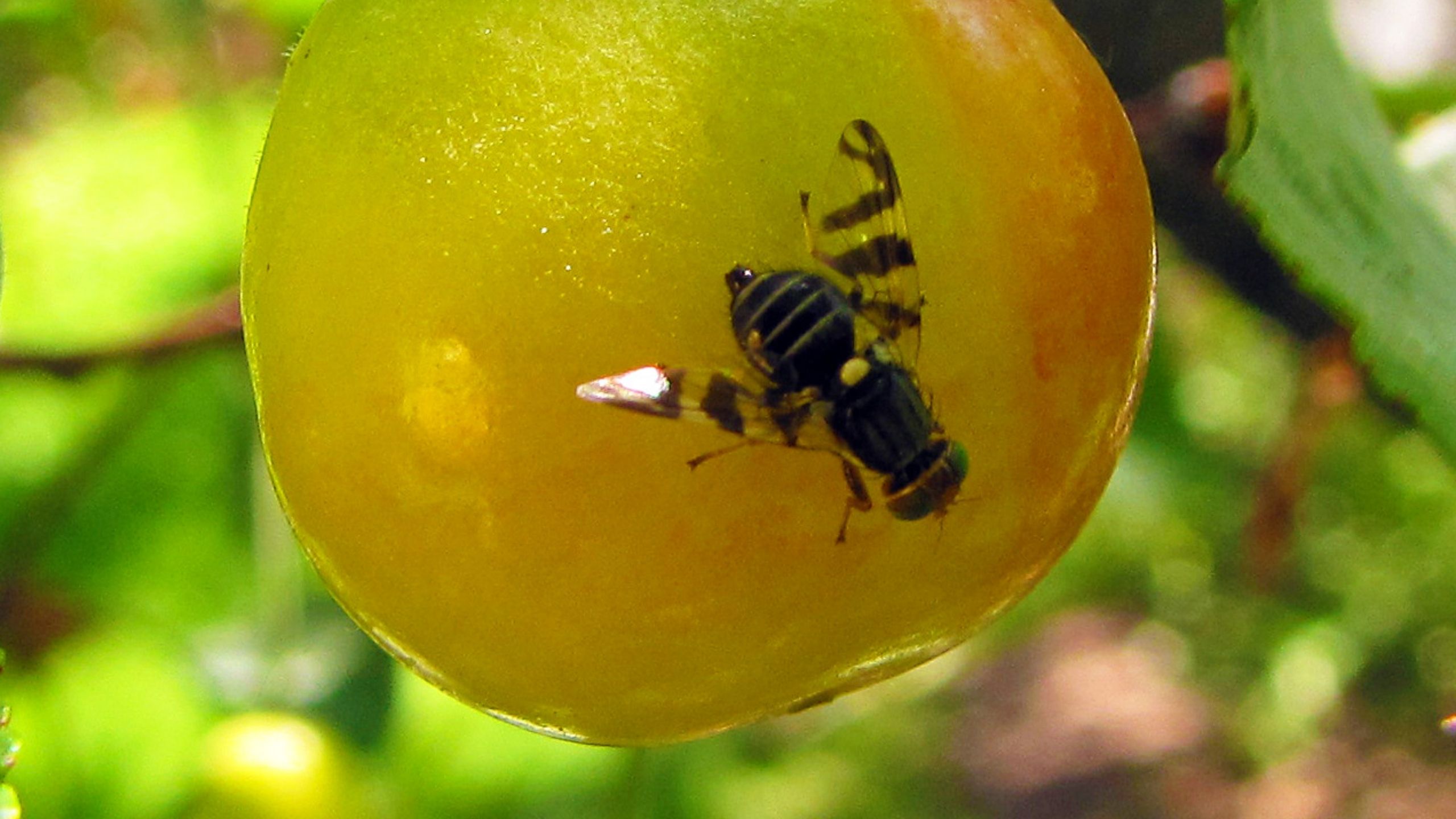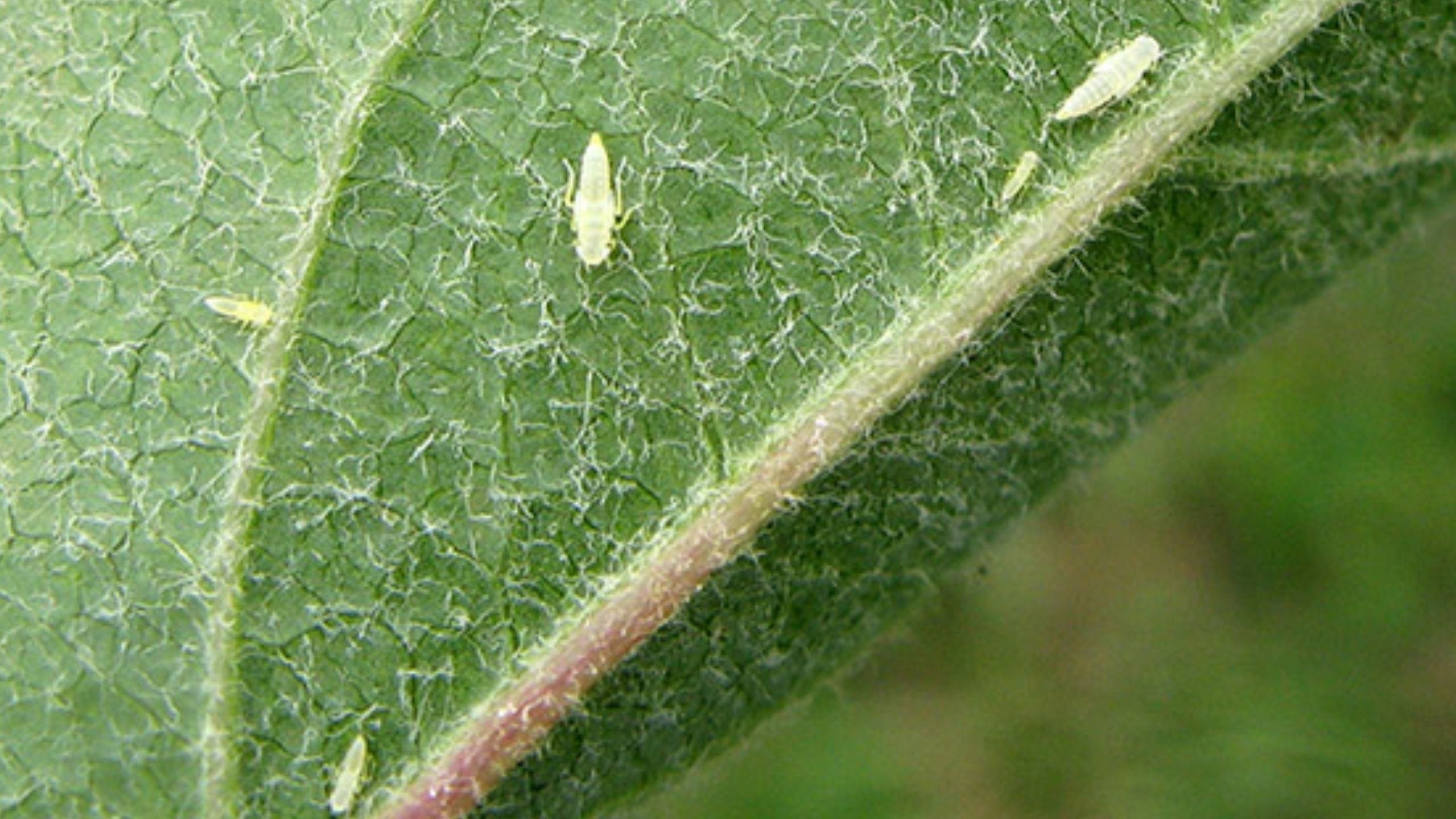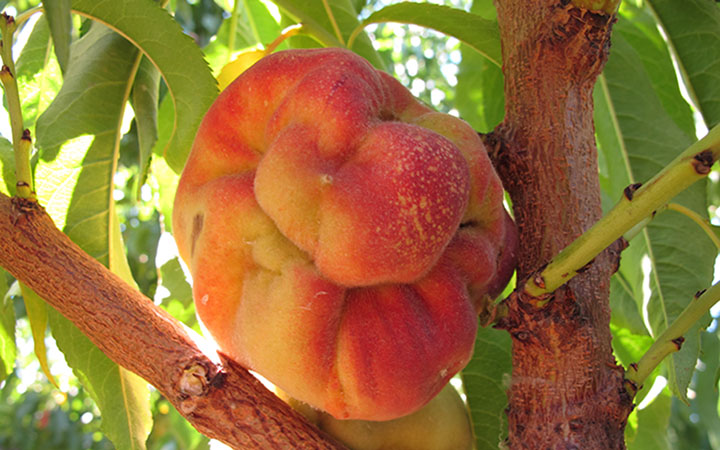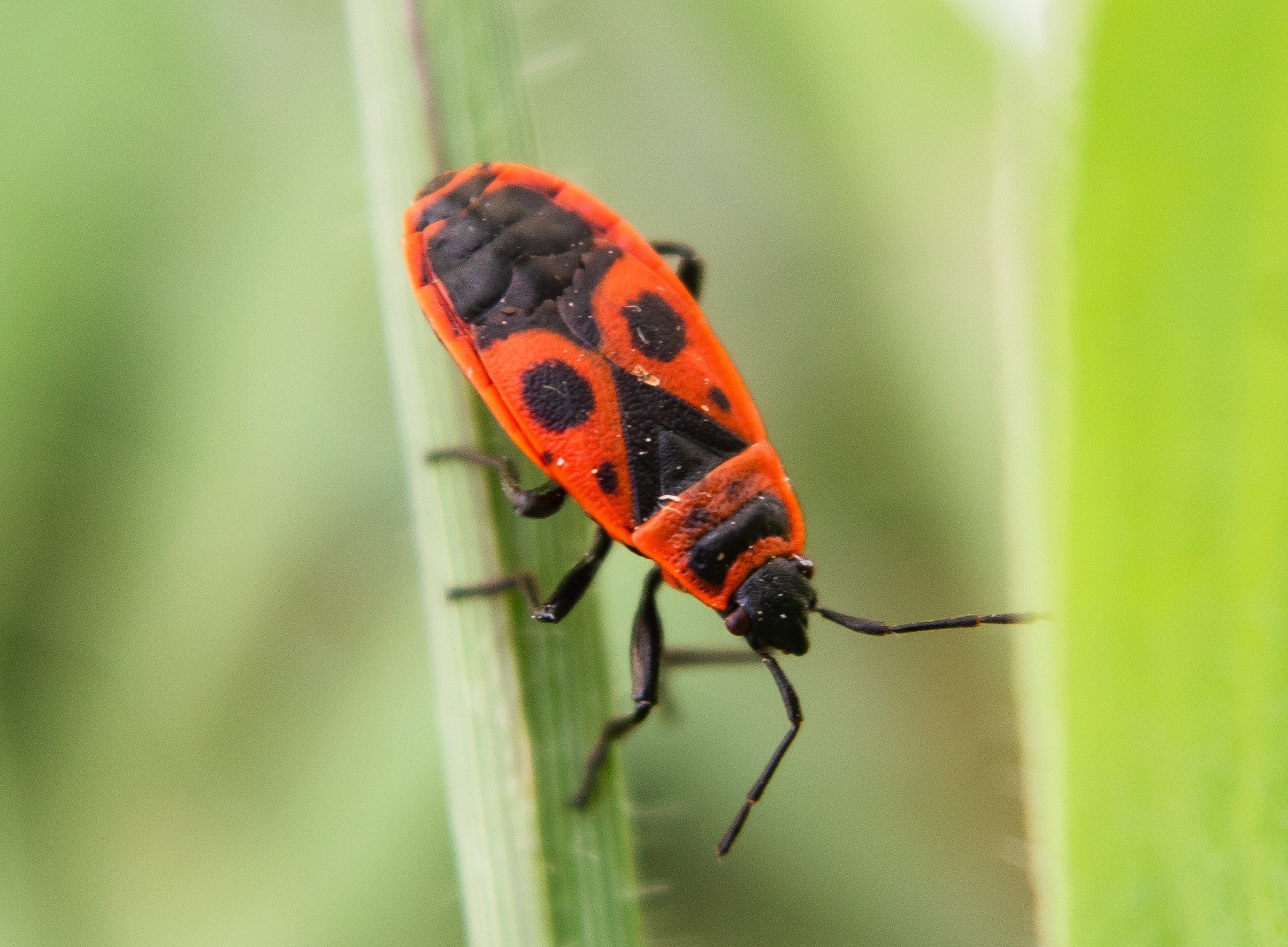Western Cherry Fruit Fly in Utah Orchards
January 2020
Diane Alston, Extension Entomologist (No longer at USU) • Marion Murray, Extension IPM Specialist
Do You Know?
- Western cherry fruit fly is the primary insect pest of sweet and tart cherries in Utah.
- Damage occurs from the larva developing inside fruit and feeding on the flesh.
- Females lay eggs under the skin of fruit, and therefore, adults are targeted for control.
- Insecticides are currently the most effective control method.
- Attract-and-kill (bait plus insecticide) can be effective.
- Use of ground barriers (mulch, fabrics) can reduce pupation and fly emergence.
- Post-harvest sanitation can reduce populations.
The western cherry fruit fly (Rhagoletis indifferens, Order Diptera, Family Tephritidae) is the most important pest of sweet and tart cherries in Utah. Once the skin of fruits becomes soft enough to penetrate, adult females (Fig. 1) insert eggs with their ovipositor, and larvae develop inside the fruits (Fig. 2). The result is “wormy” fruit that is unmarketable. It is difficult to determine whether a fruit is infested until the larva exits through a hole that it chews or the fruit is cut open to reveal the larva inside. For processed cherries, detection of one larva by the processor can result in rejection of the entire crop from that orchard and/or farm. Therefore, the best management strategy is to prevent fruit infestation.
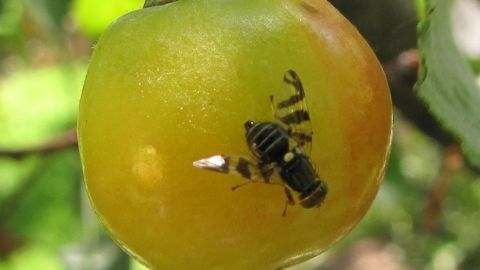
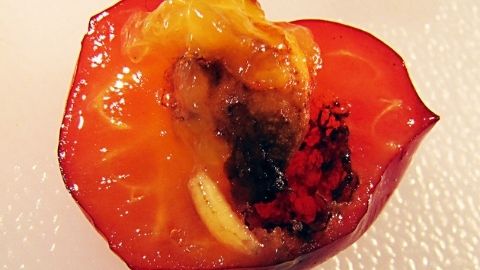
Adult flies will migrate only short distances (< 40 yd) if host fruit is available. This causes infestations to be spotty in a region; however, once established in an orchard, the western cherry fruit fly can spread rapidly and require annual control. Protective insecticide sprays are currently the major tactic for preventing infestation. An “attractand-kill” technology where adult flies are enticed to feed on a sticky bait droplet containing an ultra low concentration of insecticide, has proven effective in Utah orchards.
There is one generation per year; however, adults can emerge from the soil over a period of 3 months or more. Cherry fruits are susceptible to infestation from when they first ripen to a salmon-blush color until they become too soft or fall from the tree.
Hosts
Sweet, tart, and wild species of cherries
Life History
Pupa – Overwintering Stage
- Size: about 3/16 inch long
- Color: light to dark brown and shaped like a large grain of wheat
- Where: overwinters in the soil of the orchard floor, 1 - 4 inches deep
- Rate of pupal development and adult emergence affected by soil temperature and moisture
Adult – Monitoring Stage
- Size: about 1 /5 inch long
- Color: black body with white bands on abdomen (posterior body region); wings are transparent with a distinctive pattern of dark bands (Figs. 1 and 5)
- When: adults begin emerging from soil in late May to early June depending on soil temperature and moisture, and continue to emerge throughout the summer and into early fall (Fig. 3)
- After emerging, females require about 5 to 7 days to become sexually mature, after which they can begin laying eggs
- Females lay eggs under the skin of fruit without leaving visible marks, over a period of about 30 days
Egg
- Size: about 1/30 inch long
- Color and shape: yellowish and elongated with a stalk at one end
- Where: deposited beneath the skin of cherry fruits
- Eggs hatch in 5 - 8 days
Larva – Damaging Stage
- Size: mature larvae are about 5/16 inch long
- Color and shape: creamy white, legless maggot; tapered at the head and rounded at the tail (Fig. 2)
- Where: lives and feeds in the fruit
- After approximately 14 - 21 days, full-grown larvae exit from the fruit, drop to the ground, burrow into the soil, and pupate
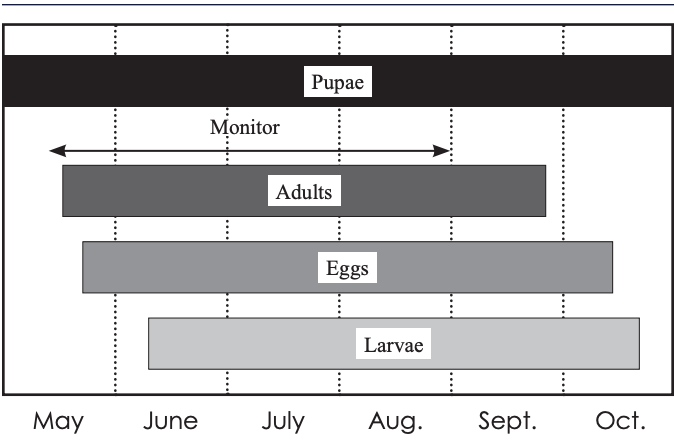
Host Injury
Larvae feed within the fruit on the flesh, rendering the fruit unmarketable (Fig. 2). There is no noticeable evidence on the outside of a fruit indicating infestation until after larvae emerge through exit holes. Large populations can infest a high percentage of the fruit on a tree. Peak emergence of adults and infestation of fruit occurs from mid-June to mid-July.
Timing Control
Insecticide treatments should be timed to prevent adult mating and/or female fruit flies from laying eggs in developing fruit. There are three methods to determine proper timing of sprays. Method 1 should be used in combination with Methods 2 or 3.
Method 1: Fruit Maturity
Cherry fruits are not susceptible to egg-laying by adult females until they ripen to a salmon-blush in color. Green fruits will not be attacked. Consider the maturity of the ripest fruit in an orchard, not the average.
Method 2: Adult Trapping
Adult flies do not use sexual pheromones, but are attracted to certain colors and odors. Yellow sticky panel traps (Pherocon AM®) with an external bait of ammonium carbonate (AC) are a moderately effective monitoring tool (Fig. 4); unbaited traps should not be used. Place traps in cherry orchards before the first fly is expected (750-800 degree days [DD]), or by mid-May (Table 1). Apply the first insecticide treatment 5 to 7 days (190 DD) after first catch (females require this amount of time for ovaries to mature after emergence).
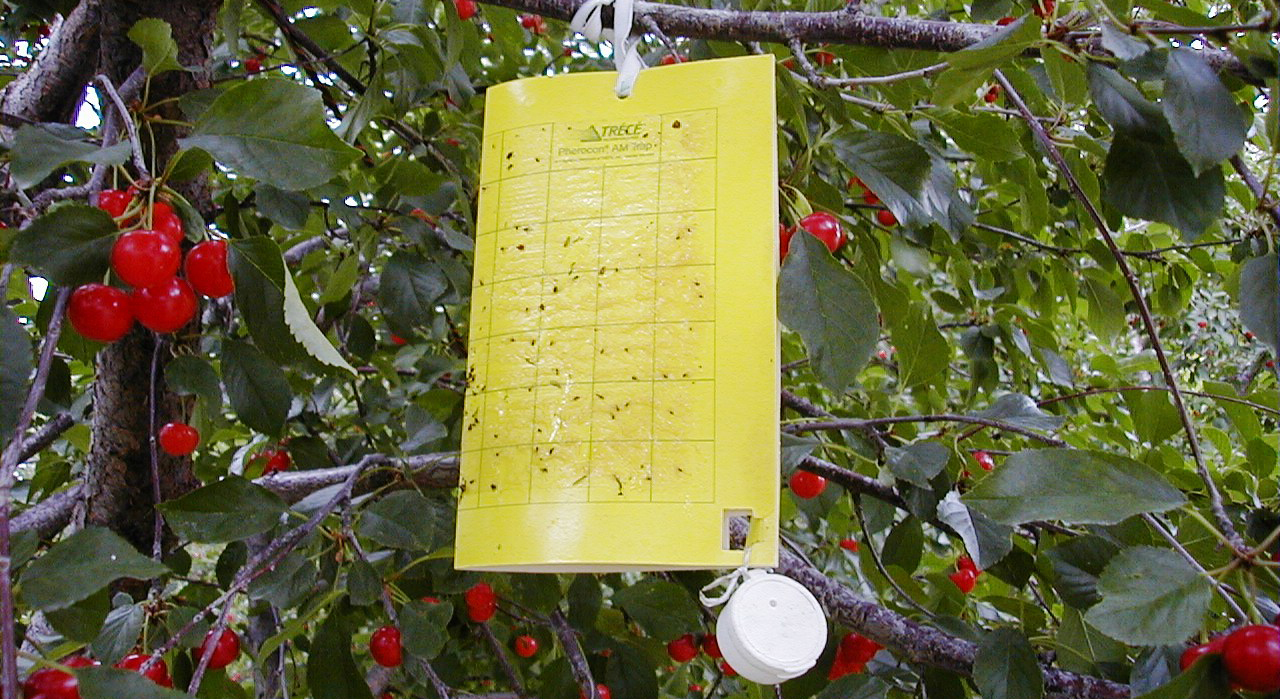
Trap Placement and Servicing
- Place AC-baited Pherocon AM® traps on the southern side of trees (flies emerge first and are more active on the warmer side of trees).
- Place traps at least 6 ft high, preferably in the upper 1 /3 of the tree canopy.
- Remove fruit, leaves, and twigs within 6 inches of the trap.
- A minimum of two traps should be placed in each orchard. Research conducted in Utah commercial cherry orchards ≥ 10 acres in size has shown that one to two traps per acre catches significantly more flies than four traps per orchard. Differences in fly activity on orchard borders versus interiors can be determined by placing traps in representative locations.
- Suspected “hot spots” within an orchard should be monitored separately.
- Maintain and check traps weekly throughout the fruit development period. Change traps every 3 - 4 weeks or when they become covered with debris.
- Refill or replace AC bait containers as needed.
- Keep a record of trap catches for each location within an orchard and for each orchard. This information can be used to determine first fly emergence, timing of first cover spray, relative fly activity across orchards, and help in evaluating success of your fruit fly management program.
- More than one species of fruit fly may be caught on traps. Inspect the banding pattern on wings to determine the species (Fig. 5).
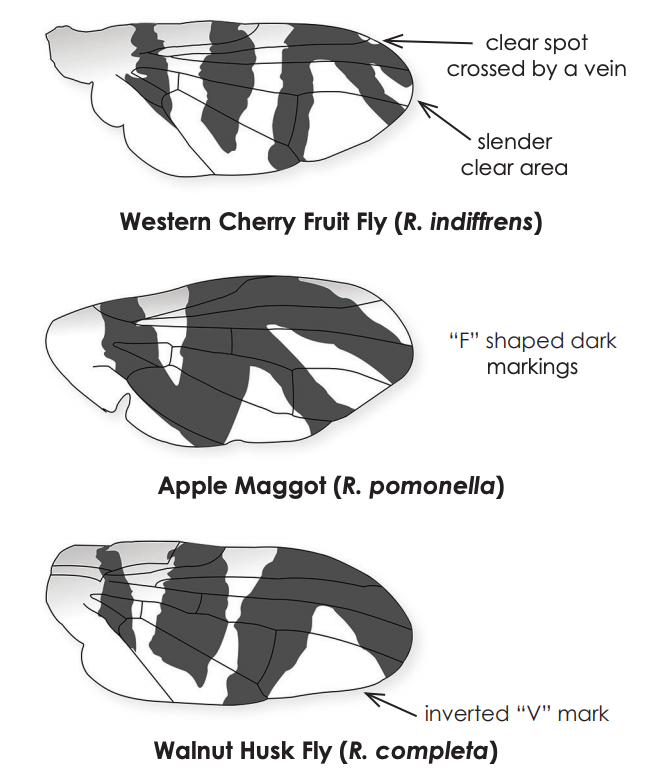
Method 3: Degree-Day Model
Use 1060 DD as a guideline (41° F lower threshold for development, Table 1) to initiate cover sprays if you don’t have fly trapping information. This timing corresponds to 3 percent fly emergence and 1 percent of females with mature ovaries. In order to use a DD method, daily air temperature data must be available. The Utah Climate Center provides site-specific DD information on their web tool, Utah TRAPs (Temperature Resource and Alerts for Pests) at climate.usu.edu/traps.
Also consider the history of fruit fly populations and fruit infestation in an orchard to help guide initiation of insecticide sprays. First adult emergence will tend to be earlier in orchards with higher fruit fly densities (Fig. 6).
 Fig. 6.Relationship between fruit fly density and date of first adult emergence.
Fig. 6.Relationship between fruit fly density and date of first adult emergence.
Table 1. Major events in western cherry fruit fly management. Timing of events is based on degreeday accumulations and first activity of adults.
| Degree Days (DD) | Management Event |
|---|---|
| 750-800 | Place traps in orchards |
| 900-950 | First adult flies expected on traps; Treat 5-7 days or 190 DD after first fly is caught if cherries have developed a salmoncolored blush; otherwise wait for fruit to turn color |
| 1060 | 3% of flies emerged, 1% of flies sexually mature; If you don’t have trap catch information, use 1060 DD and fruit maturity guidelines (above) to time the first spray. Re-apply cover sprays based on insecticide protection interval and anticipated harvest date of crop. |
The western cherry fruit fly model is based on a 41°F lower threshold and no upper threshold for development. Begin accumulating DD starting Jan 1.
Management
Cultural Controls
Ground Cover and Mulches
Ground covers and mulches around the base of trees can prevent larvae from burrowing into the soil to complete development into the pupal stage. Successful vegetation covers include grasses and other plants with extensive, dense root systems (e.g., clover) that physically impede fruit fly larvae. Landscape fabric can prevent larval burrowing and emergence of adults from pupae in the soil (Fig. 7). Mulches of other dense materials may also interfere with their life cycle.
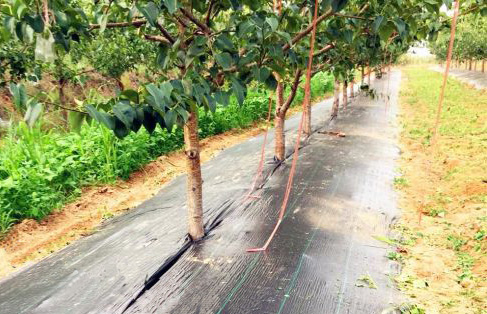
Sanitation
Maintaining a “clean” orchard wherein the fruit fly population is kept at low levels from one year to the next is important because high populations are more difficult to control, even with insecticides. In years when the crop is not harvested or not all fruit is removed from trees, fruit fly populations can increase and cause greater pest pressure the following year. Therefore, it is important to remove dropped fruit from the orchard floor as it may contain larvae. In addition, remove any nearby abandoned or wild cherry trees to prevent them from serving as unmanaged hosts that contribute to the local fruit fly population.
Biological Control
There are some natural enemies that will attack fruit fly life stages, such as parasitic wasps that lay eggs on larvae within fruit, but control has not been shown to be significant. Birds and rodents take a larger toll on fruit fly larvae, but they generally also consume the fruit and so are not considered beneficial. Chicken and other fowl have been shown to eat fruit fly larvae and pupae in the soil and may provide some benefit.
Insecticides
Insecticide sprays targeting the adult are the primary tactic for controlling this pest (see Table 2). Larvae of the fruit fly develop within the fruit where they are protected from most insecticides. Research on penetration of insecticides into fruit has shown that some of the neonicotinoid insecticides move through the skin and can kill insect eggs and larvae within the fruit. The main target for control is still prevention of females laying eggs in fruit.
The zero-tolerance level of fruit flies in processed cherries has made perfect control a necessity. Home growers can help the commercial cherry industry by maintaining fruit fly control in backyard orchards. Once control treatments begin based on timing information described above, maintain protection of fruit through harvest. Reapply insecticides based on the protection interval stated on the label. It is best to rotate the type of insecticide applied between applications to reduce development of resistance and negative effects on beneficial insects and mites. For example, insecticides such as carbaryl, malathion, and the synthetic pyrethroids are especially toxic to predatory mites.
No insecticides are currently registered for soil application for control of cherry fruit fly. Preliminary research has shown some efficacy of entomopathogenic nematodes against larvae in the soil.
Attract-and-Kill Technology
GF-120 is a mixture of an adult attractant and an ultra low concentration of spinosad insecticide. In commercial orchards it is applied with an ATV-mounted, electricpump sprayer (Fig. 8). In home cherry trees, it can be applied with a hand-pump sprayer. Full coverage of foliage and fruit is not required as adults are enticed to feed on small droplets of sticky bait and insecticide. Research in Utah orchards has shown it to be as effective as most traditional insecticides where populations are low. It is not rain-fast and must be reapplied at least every 7 days.
It is critical to keep an adequate number of baitinsecticide droplets available to kill adults soon after they emerge and before they mate and/or females lay eggs. Currently it is only sold in larger volumes; larger than is practical for most home orchards.
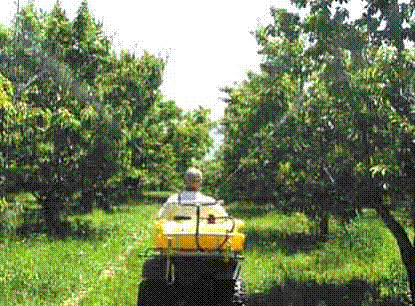
Table 2. Insecticide options for commercial and residential sites, listed by Mode of Action (MOA).
| MOA | Ingredient | Commercial | Residential | Efficacy | Notes |
|---|---|---|---|---|---|
| Conventional Options | |||||
| 1 | carbaryl | Sevin 4F | 3-4 | ||
| 1 | dimethoate | Dimethoate 4EC | 4 | Post-harvest option for fly knockdown | |
| 1 | malathion | Malathion 57EC | Hi-Yield Malathion; Spectracide Malathion | 4 | |
| 1 | phosmet | Imidan 70 W | 3-4 | Do not use on sweet cherry | |
| 3 | beta-cyfluthrin | Baythroid XL | 3 | ||
| 3 | esfenvalerate | Asana XL | Monterey Bug Buster II | 3 | |
| 3 | gamma-cyhalothrin | Spectracide Triazicide Insect Killer | 3-4 | ||
| 3 | lambda-cyhalothrin | Warrior II | Bonide Fruit Tree & Plant Guard | 2-3 | |
| 3 | zeta-cypermethrin | GardenTech Sevin; Gordon’s Bug-No-More | 3-4 | ||
| 3/4 | cyfluthrin/ imidacloprid | Leverage 360 | 3-4 | ||
| 3/28 | lambda-cyhalothrin/ chlorantraniliprole | Voliam Xpress | 3-4 | ||
| 4 | acetamiprid | Assail 30 SG | 3 | ||
| 4 | imidacloprid | Admire Pro | 3 | ||
| 4 | thiamethoxam | Actara | 3 | ||
| 5 | spinetoram | Delegate WG | 3 | ||
| 5 | spinosad | Success | Bonide Captain Jack’s Deadbug Brew | 2-3 | |
| 28 | chlorantraniliprole | Altacor | 2-3 | ||
| 28 | cyantraniliprole | Exirel | 4 | ||
| Organic Options | |||||
| 4 | pyrethrin | PyGanic, Tersus | Fertilome Triple Action | 2 | Re-apply after 5 days |
| 5 | spinosad | Entrust | Monterey Garden Insect Spray | 2-3 | |
| 5 | spinosad + bait | GF-120 NF | 2-4 | More effective in low fly populations | |
Restricted use products that require an applicator license.
The brands shown above are not all-inclusive, but are meant to provide examples of insecticides registered on cherry trees in Utah.


